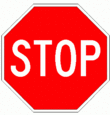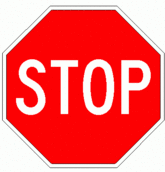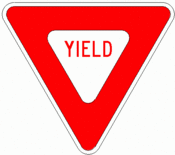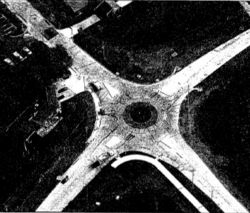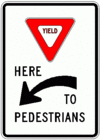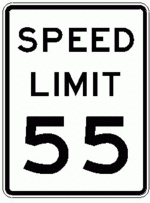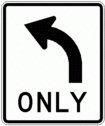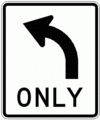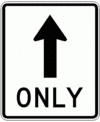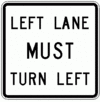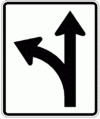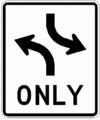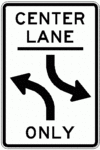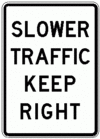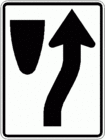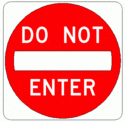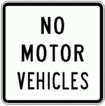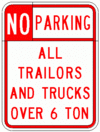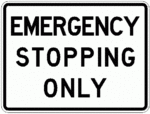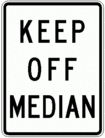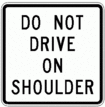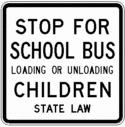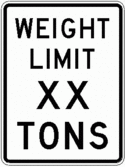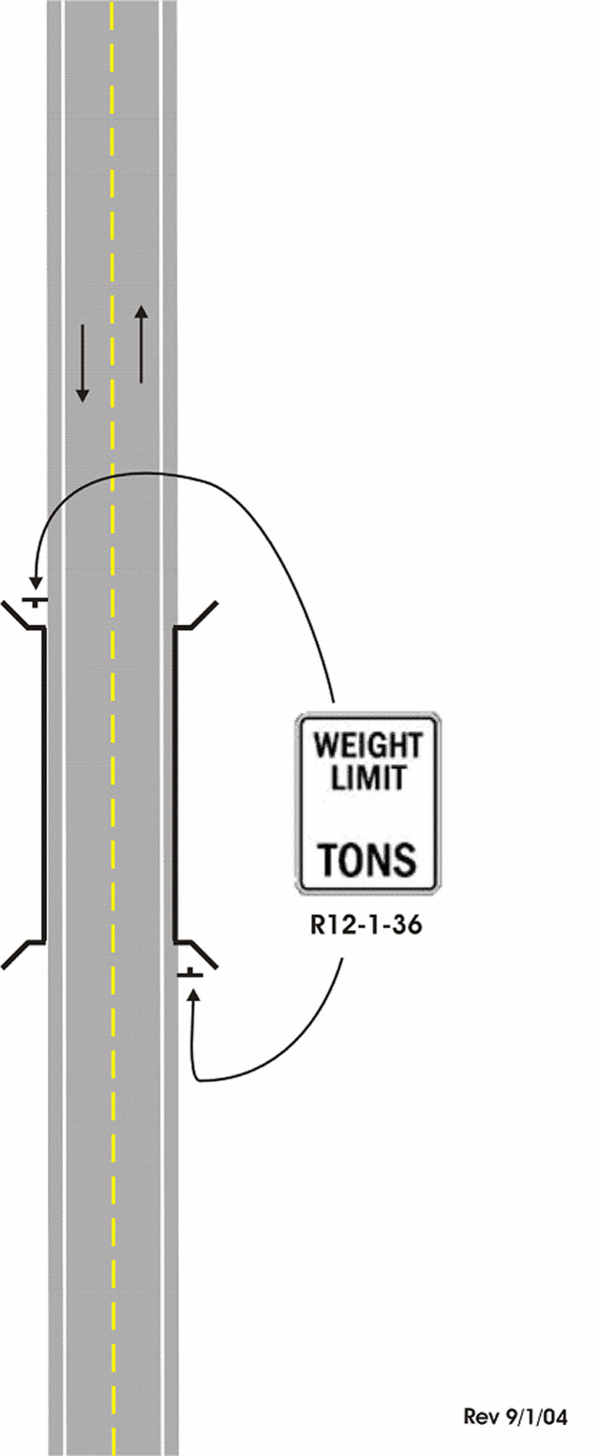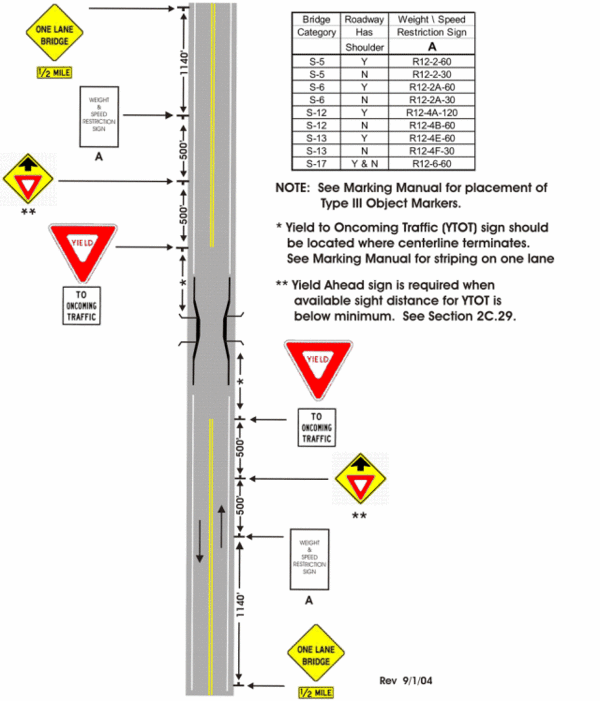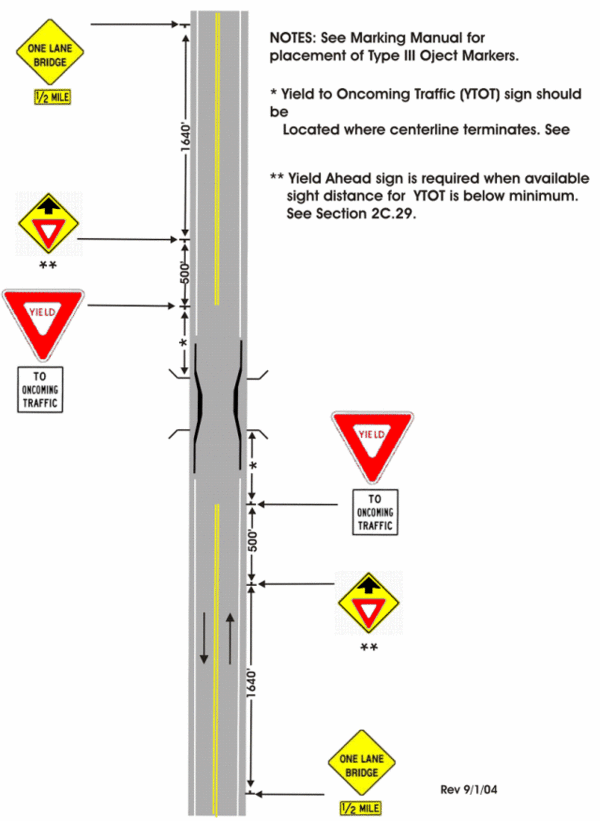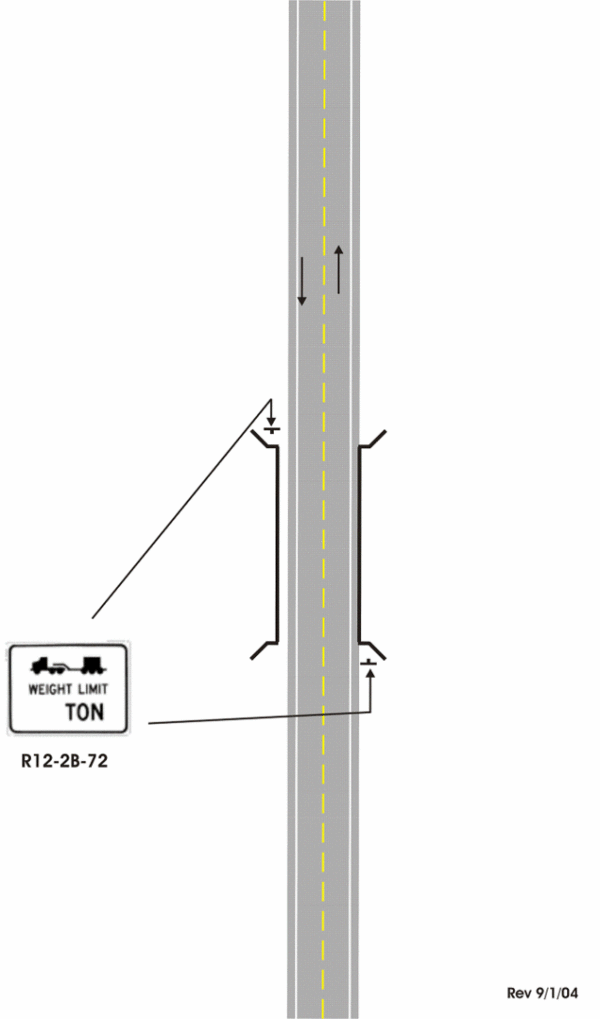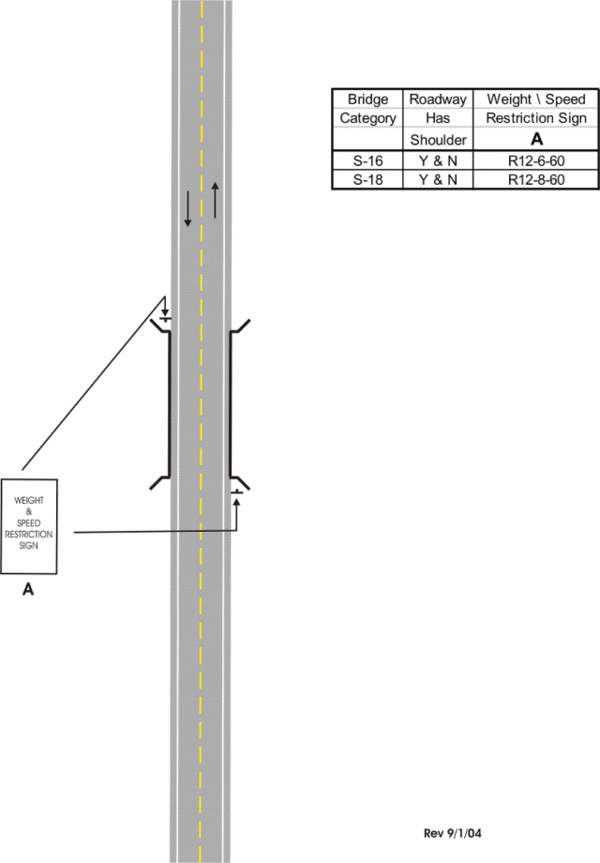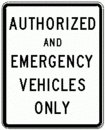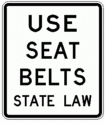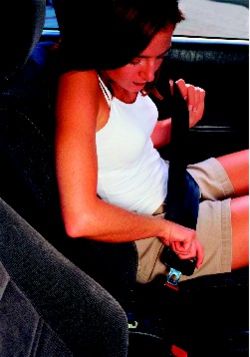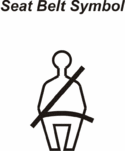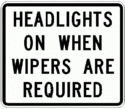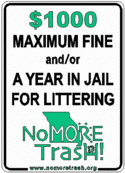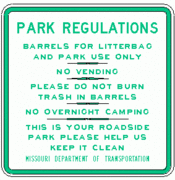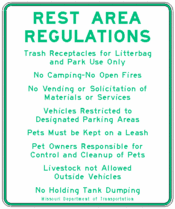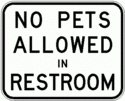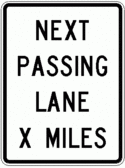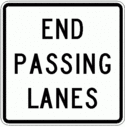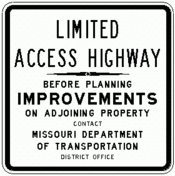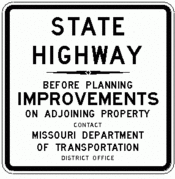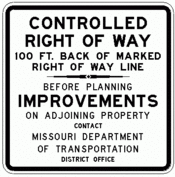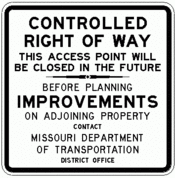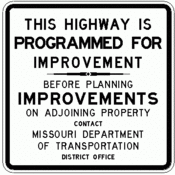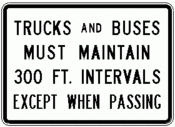903.5 Regulatory Signs
 |
 |
 |
 |

|
| Additional Information |
| How Speed Limits are Established |
Contents
- 1 903.5.1 Application (MUTCD Section 2B.01)
- 2 903.5.2 Design (MUTCD Section 2B.02)
- 3 903.5.3 Dimensions (MUTCD Section 2B.03)
- 4 903.5.4 STOP Sign (R1-1) (MUTCD Section 2B.04)
- 5 903.5.5 YIELD Sign (R1-2, R1-2a) (MUTCD Section 2B.08)
- 6 903.5.6 YIELD HERE TO PEDESTRIANS Signs (R1-5, R1-5a) (MUTCD Section 2B.11)
- 7 903.5.7 IN-STREET PEDESTRIAN CROSSING Sign (R1-6, R1-6a) (MUTCD Section 2B.12)
- 8 903.5.8 SPEED LIMIT Sign (R2-1) (MUTCD Section 2B.13)
- 9 903.5.9 TRUCK SPEED LIMIT Sign (R2-2) (MUTCD Section 2B.14)
- 10 903.5.10 NIGHT SPEED LIMIT Sign (R2-3) (MUTCD Section 2B.15)
- 11 903.5.11 MINIMUM SPEED LIMIT (R2-4) and Combination Speed Limit Sign (R2-4a) (MUTCD Section 2B.16a)
- 12 903.5.12 SPEED LIMIT XX EXCEPT WHERE POSTED Signs (R2-8) (MUTCD Section 2B.16b)
- 13 903.5.13 FINES HIGHER (R2-4) (MUTCD Section 2B.17)
- 14 903.5.14 Location of Speed Limit Signs (MUTCD Section 2B.18)
- 15 903.5.15 TURN PROHIBITION Signs (R3-1 through R3-4 and R3-18) (MUTCD Section 2B.19)
- 16 903.5.16 INTERSECTION LANE CONTROL Signs (R3-5 through R3-8) (MUTCD Section 2B.20)
- 17 903.5.17 MANDATORY MOVEMENT LANE CONTROL Signs (R3-5, R3-5a and R3-7)(MUTCD Section 2B.21)
- 18 903.5.18 OPTIONAL LANE CONTROL Sign (R3-6) (MUTCD Section 2B.22)
- 19 903.5.19 ADVANCED INTERSECTION LANE CONTROL Signs (R3-8 Series) (MUTCD Section 2B.23)
- 20 903.5.20 TWO-WAY LEFT TURN ONLY/CENTER LANE ONLY Signs (R3-9a, R3-9b)(MUTCD Section 2B.24)
- 21 903.5.21 REVERSIBLE LANE CONTROL Signs (R3-9d, R3-9f through R3-9i)(MUTCD Section 2B.25)
- 22 903.5.22 PREFERENTIAL ONLY LANES Sign (R3-10 through R3-15) (MUTCD Section 2B.26)
- 23 903.5.23 Preferential Only Lanes for High Occupancy Vehicles (HOV)(MUTCD Section 2B.27)
- 24 903.5.24 Preferential Only Lanes Sign Applications and Placement (MUTCD Section 2B.28)
- 25 903.5.25 DO NOT PASS Sign (R4-1) (MUTCD Section 2B.29)
- 26 903.5.26 PASS WITH CARE (R4-2) (MUTCD Section 2B.30)
- 27 903.5.27 SLOWER TRAFFIC KEEP RIGHT (R4-3) (MUTCD Section 2B.31)
- 28 903.5.28 SLOW MOVING TRAFFIC LANE Signs (R4-5, R4-6) (MUTCD Section 2B.32)
- 29 903.5.29 KEEP RIGHT AND KEEP LEFT Signs (R4-7, R4-7b, R4-8, R4-17) (MUTCD Section 2B.33)
- 30 903.5.30 DO NOT ENTER Sign (R5-1) (MUTCD Section 2B.34)
- 31 903.5.31 WRONG WAY Sign (R5-1a) (MUTCD Section 2B.35)
- 32 903.5.32 Selective Exclusion Signs (MUTCD Section 2B.36)
- 33 903.5.33 ONE WAY Signs (R6-1, R6-2) (MUTCD Section 2B.37)
- 34 903.5.34 DIVIDED HIGHWAY CROSSING Signs (R6-3, R6-3a, R6-3b) (MUTCD Section 2B.38)
- 35 903.5.35 Parking, Standing and Stopping Signs (R7 and R8 Series) (MUTCD Section 2B.39)
- 36 903.5.36 NO PARKING ALL TRAILERS AND TRUCKS OVER 6 TONS (R7-104)
- 37 903.5.37 RESERVED PARKING For Persons with Disabilities Sign (R7-8, R7-8b)
- 38 903.5.38 EMERGENCY STOPPING ONLY Sign (R8-7) (MUTCD Section 2B.42)
- 39 903.5.39 WALK ON LEFT FACING TRAFFIC and NO HITCHHIKING Signs (R9-1, R9-4 and R9-4a) (MUTCD Section 2B.43)
- 40 903.40 PEDESTRIAN CROSSING Signs (R9-2, R9-3) (MUTCD Section 2B.44)
- 41 903.5.41 TRAFFIC SIGNAL Signs (R10-3b, R10-3c, R10-5, R10-6, R10-6R, R10-6L, R10-7, R10-7a, R10-10, R10-10R, R10-10L, R10-11a, R10-11c, R10-12, R10-13, R10-21) (MUTCD Section 2B.45)
- 42 903.5.42 PHOTO ENFORCED Signs (R10-18, R10-19) (MUTCD Section 2B.46)
- 43 903.5.43 KEEP OFF MEDIAN Sign (R11-1) (MUTCD Section 2B.47)
- 44 903.5.44 ROAD CLOSED Sign (R11-2) and LOCAL TRAFFIC ONLY Signs (R11-3 Series, R11-4) (MUTCD Section 2B.48)
- 45 903.5.45 DO NOT DRIVE ON SHOULDER Sign (R11-5)
- 46 903.5.46 STOP FOR SCHOOL BUS Sign (R16-6)
- 47 903.5.47 WEIGHT LIMIT Sign (R12-1) (MUTCD Section 2B.49)
- 48 903.5.48 WEIGH STATION Signs (R13 series) (MUTCD Section 2B.50)
- 49 903.5.49 TRUCK ROUTE Sign (R14-1) (MUTCD Section 2B.51)
- 50 903.5.50 HAZARDOUS MATERIAL Signs (R14-1, R14-3) (MUTCD Section 2B.52)
- 51 903.5.51 NATIONAL NETWORK Signs (R14-4, R14-5) (MUTCD Section 2B.53)
- 52 903.5.52 Other Regulatory Signs (MUTCD Section 2B.54)
- 53 903.5.53 AUTHORIZED AND EMERGENCY VEHICLES ONLY (R5-19)
- 54 903.5.54 Seatbelt Signs (R16-2, R16-3)
- 55 903.5.55 STATE LAW MOVE OVER OR SLOW DOWN FOR STOPPED EMERGENCY VEHICLE Sign (R16-4)
- 56 903.5.56 HEADLIGHTS ON WHEN WIPERS ARE REQUIRED Sign (R16-5)
- 57 903.5.57 Regulatory Signs Provided for Other Agencies
- 58 903.5.58 Noise Ordinance Signing
- 59 903.5.59 Municipal Ordinance Number
- 60 903.5.60 RESUME SPEED THANK YOU sign (R2-9)
- 61 903.5.61 Regulatory Signs For Trash/Dumping (R5-17, R5-18)
- 62 903.5.62 Regulations For Roadside Parks (R19-1)
- 63 903.5.63 Rest Area Signing (R19 series)
- 64 903.5.64 PASSING LANE Signs (R4-13, R4-14)
- 65 903.5.65 Access Management Signing (R22-1, R22-2, R22-3, R22-4, R22-5)
- 66 903.5.66 Trucks and Buses 300 Ft Interval Sign (R4-15)
- 67 903.5.67 FINES DOUBLED ENDS Sign (R2-20)
903.5.1 Application (MUTCD Section 2B.01)
Standard. Regulatory signs shall be used to inform road users of selected traffic laws or regulations and indicate the applicability of the legal requirements.
Regulatory signs shall be installed at or near where the regulations apply. The signs shall clearly indicate the requirements imposed by the regulations and shall be designed and installed to provide adequate visibility and legibility in order to obtain compliance.
Regulatory signs shall be retroreflective or illuminated to show the same shape and similar color by both day and night, unless specifically stated otherwise in the text discussion of a particular sign or group of signs (see 903.1.15, Retroreflectivity and Illumination).
The requirements for sign illumination shall not be considered to be satisfied by street, highway, or strobe lighting.
903.5.2 Design (MUTCD Section 2B.02)
Support. Most regulatory signs are rectangular, with the longer dimension vertical. The shapes and colors of regulatory signs are listed in Tables 903.1.17 and 903.1.18.1, respectively. The use of educational plaques to supplement symbol signs is described in 903.1.20, Symbols.
Changeable message signs displaying a regulatory message incorporating a prohibitory message that includes a red circle and slash on a static sign should display a red symbol that approximates the same red circle and slash as closely as possible.
903.5.3 Dimensions (MUTCD Section 2B.03)
Standard. The sizes for regulatory signs shall be as shown in Table 903.5.3, below.
Guidance. The freeway and expressway sizes should be used for higher-speed applications to provide larger signs for increased visibility and recognition.
Option. The minimum size may be used on low-speed roadways where the reduced legend size would be adequate for the regulation or where physical conditions preclude the use of the other sizes. The oversized size may be used for those special applications where speed, volume or other factors result in conditions where increased emphasis, improved recognition or increased legibility would be desirable.
Table 903.5.3 Regulatory Sign Sizes
| Sign | Sign Number | Article | Conventional | Expressway (At Grade) | Freeway (Grade Separated) | Other |
|---|---|---|---|---|---|---|
| STOP | R1-1 | 903.5.4 | 36x36 (*48x48) | - | - | 36 x 36 (*48 x 48) (ramp) |
| FOUR-WAY | R1-3 | 903.5.4 | 24 x 12 | - | - | - |
| THREE-WAY | R1-3A | 903.5.4 | 24 x 12 | - | - | - |
| ALL-WAY | R1-4 | 903.5.4 | 24 x 9 | - | - | - |
| YIELD | R1-2 | 903.5.5 | 48 x 48 (*60 x 60) | - | - | 48 x 48 (*60 x 60) (ramp) |
| TO ONCOMING TRAFFIC | R1-2A | 903.5.5 | 36 x 30 (*60 x 60) | - | - | 36 x 30) |
| YIELD HERE TO PEDESTRIANS (SYMBOL) | R1-5 | 903.5.6 | 18 x 18 | - | - | - |
| YIELD HERE TO PEDESTRIANS | R1-5a (L/R) | 903.5.6 | 18 x 24 | - | - | - |
| SPEED LIMIT | R2-1 | 903.5.8 | 36 x 48 | 36 x 48 | 48 x 60 | - |
| COMBINATION SPEED LIMIT | R2-4A | 903.5.11 | - | - | 48 x 96 (interstate only) | - |
| SPEED LIMIT _____ EXCEPT WHERE POSTED | R2-8 | 903.5.12 | 30 x 42 | 30 x 42 | 30 x 42 (non interstate) | - |
| NO RIGHT TURN (SYMBOL) | R3-1 | 903.5.15 | 24 x 24 (*48 x 48) | 24 x 24 (*48 x 48) | 24 x 24 (*48 x 48) | - |
| NO LEFT TURN (SYMBOL) | R3-2 | 903.5.15 | 24 x 24 (*48 x 48) | 36 x 36 (*48 x 48) | 36 x 36 (*48 x 48) | - |
| NO TURNS | R3-3 | 903.5.15 | 36 x 36 | - | - | - |
| NO U TURN (SYMBOL) | R3-4 | 903.5.15 | 24 x 24 (*48 x 48) | - | - | - |
| NO U TURN/NO LEFT TURN | R3-18 | 903.5.15 | 24 x 24 (*48 x 48) | - | - | - |
| RIGHT (LEFT/AHEAD) ONLY | R3-5R(L/A) | 903.5.17 | 30 x 36 | - | - | - |
| RIGHT (LEFT) LANE MUST TURN RIGHT (LEFT) | R3-7R(L) | 903.5.17 | 30 x 30 (*36 x 36) | - | - | - |
| STRAIGHT AND RIGHT (LEFT) | R3-6R(L) | 903.5.18 | 30 x 36 | - | - | - |
| TWO-WAY LEFT TURN ONLY (SYMBOL) | R3-9A | 903.5.20 | 30 x 36 (*36 x 48) | - | - | - |
| *May be used based on engineering judgment. | ||||||
| Sign | Sign Number | Article | Conventional | Expressway (At Grade) | Freeway (Grade Separated) | Other |
|---|---|---|---|---|---|---|
| CENTER LANE TWO-WAY LEFT TURN ONLY | R3-9B | 903.5.20 | 24 x 36 (*36 x 54) | - | - | - |
| DO NOT PASS | R4-1 | 903.5.25 | 30 x 42 (*36 x 48) | - | - | - |
| PASS WITH CARE | R4-2 | 903.5.26 | 30 x 42 (*36 x 48) | - | - | - |
| SLOWER TRAFFIC KEEP RIGHT | R4-3a | 903.5.27 | 30 x 42 | 48 x 60 | 48 x 60 | - |
| KEEP LEFT (RIGHT) | R4-17L(R) | 903.5.29 | 36 x 36 | 48 x 48 | 48 x 48 | - |
| KEEP RIGHT (SYMBOL) | R4-7 | 903.5.29 | 24 x 30 (*36 x 48) | - | - | - |
| KEEP LEFT (SYMBOL) | R4-8 | 903.5.29 | 24 x 30 (*36 x 48) | - | - | - |
| KEEP RIGHT (HORIZONTAL ARROW) | R4-7A | 903.5.29 | 36 x 48 | 48 x 60 | 48 x 60 | - |
| KEEP RIGHT (45 DEGREE ARROW) | R4-7B | 903.5.29 | - | 84 x 96 | 84 x 96 | - |
| DO NOT ENTER | R5-1 | 903.5.30 | - | 36 x 36 | 36 x 36 (non-interstate) 48 x 48 (interstate only) | 30 x 30 (back of yield or stop) |
| WRONG WAY | R5-1a (R5-1b) | 903.5.31 | - | 36 x 24 (*42 x 30) | 42 x 30 | - |
| PEDESTRIANS PROHIBITED | R5-10c | 903.5.32 | 24 x 12 | 24 x 12 | 24 x 12 | - |
| NO MOTOR VEHICLES | R5-3 | 903.5.32 | - | - | - | 24 x 24 (bicycle) |
| NO VENDING | R5-15 | 903.5.32 | - | - | - | 24 x 24 |
| NO FISHING FROM BRIDGE | R5-16 | 903.5.32 | - | - | - | 18 x 24 |
| NO PARKING ON BRIDGE | R7-102 | 903.5.32 | - | - | - | 18 x 24 |
| DO NOT STOP ON TRACKS | R5-21 | 903.5.32 | 24 x 30 | - | - | 24 x 30 |
| ONE WAY ARROW | R6-1R(L) | 903.5.33 | 36 x 12 | 48 x 18 | 48 x 18 | - |
| ONE WAY (SPACED LIMITED) | R6-2R(L) | 903.5.33 | 18 x 24 | 24 x 30 | 24 x 30 | - |
| DIVIDED HIGHWAY | R6-3B | 903.5.34 | 24 x 18 | - | - | - |
| DIVIDED HIGHWAY (4-LEGGED) | R6-3 | 903.5.34 | 24 x 18 | - | - | - |
| DIVIDED HIGHWAY (T-INTERSECTION) | R6-3A | 903.5.34 | 24 x 18 | - | - | - |
| NO PARKING SIGNS | R7 Series | 903.5.35 | 18 x 24 | - | - | - |
| COMBINATION NO PARKING | R7-200 | 903.5.35 | 36 x 24 | - | - | - |
| *May be used based on engineering judgment. | ||||||
| Sign | Sign Number | Article | Conventional | Expressway (At Grade) | Freeway (Grade Separated) | Other |
|---|---|---|---|---|---|---|
| TOW AWAY ZONE | R7-201 | 903.5.35 | 12 x 6 | - | - | - |
| NO PARKING TRUCKS AND TRAILERS OVER 6 TONS | R7-104 | 903.5.36 | - | - | - | 18 x 24 (parking lot) |
| RESERVED PARKING DISABLED/ARROW | R7-8R(L/D) | 903.5.37 | - | - | - | 12 x 18 (parking lot) |
| VAN ACCESSIBLE | R7-8B | 903.5.37 | - | - | - | 12 x 16 |
| EMERGENCY STOPPING ONLY | R8-7 | 903.5.38 | - | 48 x 36 | 48 x 36 | - |
| LEFT (RIGHT) TURN SIGNAL | R10-10L (R) | 903.5.41 | - | - | - | 24 x 30 (signal) |
| NO TURN ON RED (SYMBOL) | R10-11C | 903.5.41 | - | - | - | 24 x 30 (signal) |
| LEFT TURN YIELD ON GREEN (SYMBOLIC GREEN BALL) | R10-12 | 903.5.41 | - | - | - | 24 x 30 (signal) |
| EMERGENCY SIGNAL | R10-13 | 903.5.41 | - | - | - | 36 x 24 (*60 x 30) (signal) |
| LEFT TURN SIGNAL YIELD ON GREEN (SYMBOLIC GREEN BALL) | R10-21 | 903.5.41 | - | - | - | 30 x 36 (signal) |
| PEDESTRIAN SIGNAL SERIES | R10-3 series, R10-4 | 903.5.41 | - | - | - | 9 x 12 (signal) |
| LEFT ON GREEN ARROW ONLY | R10-5 | 903.5.41 | - | - | - | 24 x 30 (signal) |
| STOP HERE ON RED | R10-6 | 903.5.41 | - | - | - | 24 x 36 (signal) |
| DO NOT BLOCK INTERSECTION | R10-7 | 903.5.41 | - | - | - | 24 x 30 (signal) |
| DO NOT BLOCK ENTRANCE | R10-7A | 903.5.41 | - | - | - | 24 x 30 (signal) |
| TRAFFIC LAW PHOTO ENFORCED | R10-18 | 903.5.42 | 36 x 18 | - | - | - |
| PHOTO ENFORCED | R10-19 | 903.5.42 | 24 x 18 | - | - | - |
| KEEP OFF MEDIAN | R11-1 | 903.5.43 | 36 x 48 | 48 x 60 | 48 x 60 | - |
| ROAD CLOSED | R11-2 | 903.5.44 | 48 x 30 | - | - | - |
| ROAD CLOSED _____ MILES AHEAD LOCAL TRAFFIC ONLY | R11-3 | 903.5.44 | 60 x 30 | - | - | - |
| BRIDGE OUT _____ MILES AHEAD LOCAL TRAFFIC ONLY | R11-3a | 903.5.44 | 60 x 30 | - | - | - |
| *May be used based on engineering judgment. | ||||||
| Sign | Sign Number | Article | Conventional | Expressway (At Grade) | Freeway (Grade Separated) | Other |
|---|---|---|---|---|---|---|
| ROAD CLOSED TO THRU TRAFFIC | R11-4 | 903.5.44 | 60 x 30 | - | - | - |
| DO NOT DRIVE ON SHOULDER | R11-5 | 903.5.45 | 36 x 36 | - | - | - |
| STOP FOR SCHOOL BUS | R16-6 | 903.5.45 | 24 x 24 | - | - | - |
| WEIGHT LIMIT | R12 series | 903.5.47 | varies | varies | varies | - |
| WEIGH STATION SIGNS | R12 series | 903.5.48 | - | varies | varies | - |
| AUTHORIZED AND EMERGENCY VEHICLES ONLY | R5-19 | 903.5.53 | - | 24 x 30 | 24 x 30 | - |
| USE SEAT BELTS STATE LAW | R16-2 | 903.5.54 | 36 x 42 | - | - | - |
| BUCKLE UP PLEASE WE CARE | R20-2 | 903.5.54 | - | - | - | 18 x 24 (MoDOT Facilities) |
| STATE LAW MOVE OVER OR SLOW DOWN FOR STOPPED EMERGENCY VEHICLES | R16-4 | 903.5.55 | - | - | 120 x 60 | - |
| HEADLIGHTS ON WHEN WIPERS ARE REQUIRED | R16-5 | 903.5.56 | 42 x 36 | 42 x 36 | 42 x 36 | - |
| NOISE ORDINANCE SIGNING | provided by others | 903.5.58 | - | - | - | - |
| MUNICIPAL ORDINANCE NUMBER | provided by others | 903.5.59 | - | - | - | - |
| RESUME SPEED THANK YOU | R2-9 | 903.5.60 | 36 x 48 | 36 x 48 | 36 x 48 | - |
| NO MORE TRASH | R5-17 | 903.5.61 | - | - | - | 30 x 42 (signal) |
| NO DUMPING | R5-18 | 903.5.61 | - | - | - | 48 x 24 |
| REST AREA SIGNS | R19 Series | 903.5.63 | - | - | - | varies |
| NEXT PASSING LANE X MILES | R4-13 | 903.5.64 | 36 x 48 | - | - | - |
| END PASSING LANES | R4-14 | 903.5.64 | 36 x 36 | - | - | - |
| ACCESS MANAGEMENT SIGNS | R22 Series | 903.5.65 | varies | varies | varies | - |
| TRUCKS AND BUSES MUST MAINTAIN 300 FEET | R4-15 | 903.5.66 | - | 42 x 30 | 42 x 30 | - |
| FINES DOUBLED ENDS | R2-20 | 903.5.67 | 36 x 30 | 36 x 30 | 36 x 30 | - |
| *May be used based on engineering judgment. | ||||||
903.5.4 STOP Sign (R1-1) (MUTCD Section 2B.04)
Standard. A STOP (R1-1) sign shall be used to indicate when traffic is always required to stop. The sign shall be an octagon with a white legend and border on a red background. Secondary legends shall not be used on STOP sign faces. If appropriate, a supplemental plaque (R1-3, R1-3a, or R1-4) shall be used to display a secondary legend. Such plaques shall have a white legend and border on a red background. If the number of approach legs controlled by STOP signs at an intersection is three or more, the numeral on the supplemental plaque, if used, shall correspond to the actual number of legs controlled by STOP signs.
At intersections where all approaches are controlled by STOP signs (see 903.5.4.3), a supplemental plaque 4-WAY (R1-3), 3-WAY (R1-3a) or All-WAY (R1-4) shall be mounted below each STOP sign.
Option. The ALL WAY (R1-4) supplemental plaque may be used instead of the 4-WAY (R1-3) supplemental plaque.
Support. The design and application of Stop Beacons are described in 902 Signals.
903.5.4.1 Stop Sign Applications. (MUTCD Section 2B.05)
Guidance. STOP signs should be used if engineering judgment indicates that one or more of the following conditions exist:
A. Intersection of a less important road with a main road where application of the normal right-of-way rule would not be expected to provide reasonable compliance with the law;
B. Street entering a through highway or street;
C. Unsignalized intersection in a signalized area; and/or
D. High speeds, restricted view, or crash records indicate a need for control by the STOP sign.
Standard. Because the potential for conflicting commands could create driver confusion, STOP signs shall not be installed at intersections where traffic control signals are installed and operating except as noted in Section 4D.01 of the MUTCD. Portable or part-time STOP signs shall not be used except for emergency and temporary traffic control zone purposes. Public and significant private road approaches to the state system shall have a STOP or YIELD (R1-2) sign installed.
Guidance. STOP signs should not be used for speed control.
STOP signs should be installed in a manner that minimizes the numbers of vehicles having to stop. At intersections where a full stop is not necessary at all times, consideration should be given to using less restrictive measures such as YIELD signs (see 903.5.5).
Once the decision has been made to install two-way stop control, the decision regarding the appropriate street to stop should be based on engineering judgment. In most cases, the street carrying the lowest volume of traffic should be stopped.
A STOP sign is not to be installed on the major street unless justified by a traffic engineering study.
Support. The following are considerations that might influence the decision regarding the appropriate street upon which to install a STOP sign where two streets with relatively equal volumes and/or characteristics intersect:
A. Stopping the direction that conflicts the most with established pedestrian crossing activity or school walking routes;
B. Stopping the direction that has obscured vision, dips or bumps that already require drivers to use lower operating speeds;
C. Stopping the direction that has the longest distance of uninterrupted flow approaching the intersection; and
D. Stopping the direction that has the best sight distance to conflicting traffic.
The use of the STOP sign at highway-railroad grade crossings is described in 903.17.6.7. The use of the STOP sign at highway-light rail transit grade crossings is described in Section 10C.04 of the MUTCD.
Option. Upon request of a resident of a minor private road approach, a STOP or YIELD sign may be installed. STOP or YIELD signs may be installed at any private or commercial entrance based on engineering judgment or traffic studies.
903.5.4.2 STOP Sign Placement. (MUTCD Section 2B.06)
Standard. The STOP sign shall be installed on the right side of the approach to which it applies. When the STOP sign is installed at this required location and the sign visibility is restricted, a Stop Ahead sign (see Advance Traffic Control Signs, 903.6.31) shall be installed in advance of the STOP sign.
The STOP sign shall be located as close as practical to the intersection it regulates, while optimizing its visibility to the road user it is intended to regulate.
STOP signs and YIELD signs shall not be mounted on the same post.
Guidance. Other than a DO NOT ENTER sign, no sign should be mounted back-to-back with a STOP sign in a manner that obscures the shape of the STOP sign.
Support. Location Standardization, 903.1.23, contains additional information about separate and combined mounting of other signs with STOP signs.
The ideal spacing for a STOP sign is approximately 14 ft. (4.2 m) from the edge of pavement. This allows for a 10 ft. shoulder and the signpost to be located approximately 4 ft. outside of the shoulder point.
Guidance. Stop lines, when used to supplement a STOP sign, should be located at the point where the road user should stop (see 620, Pavement Marking).
If only one STOP sign is installed on an approach, the STOP sign should not be placed on the far side of the intersection.
Where two roads intersect at an acute angle, the STOP sign should be positioned at an angle, or shielded, so that the legend is out of view of traffic to which it does not apply. Where there is a marked crosswalk at the intersection, the STOP sign should be installed in advance of the crosswalk line nearest to the approaching traffic.
Option. At wide-throat intersections or where two or more approach lanes of traffic exist on the signed approach, observance of the stop control may be improved by the installation of an additional STOP sign on the left side of the road and/or the use of a stop line. At channelized intersections, the additional STOP sign may be effectively placed on a channelizing island.
Support. Figure 903.1.12.2 shows examples of some typical placements of STOP signs.
903.5.4.3 Multiway Stop Applications. (MUTCD Section 2B.07)
Support. Multiway stop control can be useful as a safety measure at intersections if certain traffic conditions exist. Safety concerns associated with multiway stops include pedestrians, bicyclists, and all road users expecting other road users to stop. Multiway stop control is used where the volume of traffic on the intersecting roads is approximately equal.
The restrictions on the use of STOP signs described in 903.5.4.1 also apply to multiway stop applications.
Guidance. The decision to install multiway stop control should be based on an engineering study. The following criteria should be considered in the engineering study for a multiway STOP sign installation:
A. Where traffic control signals are justified, the multiway stop is an interim measure that can be installed quickly to control traffic while arrangements are being made for the installation of the traffic control signal.
B. A crash problem, as indicated by 5 or more reported crashes in a 12-month period that are susceptible to correction by a multiway stop installation. Such crashes include right- and left-turn collisions as well as right-angle collisions.
C. Minimum volumes:
- 1. The vehicular volume entering the intersection from the major street approaches (total of both approaches) averages at least 300 vehicles per hour for any 8 hours of an average day, and
- 2. The combined vehicular, pedestrian, and bicycle volume entering the intersection from the minor street approaches (total of both approaches) averages at least 200 units per hour for the same 8 hours, with an average delay to minor-street vehicular traffic of at least 30 seconds per vehicle during the highest hour, but
- 3. If the 85th-percentile approach speed of the major-street traffic exceeds 40 mph, the minimum vehicular volume warrants are 70 percent of the above values.
D. Where no single criterion is satisfied, but where Criteria B, C.1, and C.2 are all satisfied to 80 percent of the minimum values. Criterion C.3 is excluded from this condition.
Option. Other criteria that may be considered in an engineering study include:
A. The need to control left-turn conflicts;
B. The need to control vehicle/pedestrian conflicts near locations that generate high pedestrian volumes;
C. Locations where a road user, after stopping, cannot see conflicting traffic and is not able to reasonably safely negotiate the intersection unless conflicting cross traffic is also required to stop; and
D. An intersection of two residential neighborhood collector (through) streets of similar design and operating characteristics where multiway stop control would improve traffic operational characteristics of the intersection.
903.5.5 YIELD Sign (R1-2, R1-2a) (MUTCD Section 2B.08)
Standard. The YIELD (R1-2) sign shall be a downward-pointing equilateral triangle with a wide red border and the legend YIELD in red on a white background.
Support. The YEILD sign assigns right-of-way to traffic on certain approaches to an intersection. Vehicles controlled by a YIELD sign need to slow down or stop when necessary to avoid interfering with conflicting traffic.
Standard. The TO ONCOMING TRAFFIC (R1-2a) plaque shall be used to supplement the YIELD sign before one-lane bridges. Refer to Figures 903.5.47.3 and 903.5.47.4 in 903.5.47.1, Weight/Speed Restriction Signing.
903.5.5.1 YIELD Sign Applications. (MUTCD Section 2B.09)
Option. YIELD signs may be used instead of STOP signs if engineering judgment indicates that one or more of the following conditions exist:
A. When the ability to see all potentially conflicting traffic is sufficient to allow a road user traveling at the posted speed, the 85th-percentile speed, or the statutory speed to pass through the intersection or to stop in a reasonably safe manner.
B. If controlling a merge-type movement on the entering roadway where acceleration geometry and/or sight distance is not adequate for merging traffic operation.
C. The second crossroad of a divided highway, where the median width at the intersection is 30 ft. or greater. In this case, a STOP sign may be installed at the entrance to the first roadway of a divided highway and a YIELD sign may be installed at the entrance to the second roadway.
D. An intersection where a special problem exists and where engineering judgment indicates the problem to be susceptible to correction by the use of the YIELD sign.
Standard. A YIELD (R1-2) sign shall be used to assign right of way at the entrance to a roundabout intersection.
903.5.5.2 YIELD Sign Placement. (MUTCD Section 2B.10)
Standard. The YIELD sign shall be installed on the right side of the approach to which it applies. The signs shall be placed on both the left and right sides of approaches to roundabout intersections with more than one lane on the signed approach where raised splitter islands are available on the left side of the approach. When the YIELD sign is installed at this required location and the sign visibility is restricted, a YIELD AHEAD sign (see 903.6.31) shall be installed in advance of the YIELD sign.
The YIELD sign shall be located as close as practical to the intersection it regulates, while optimizing its visibility to the road user it is intended to regulate.
YIELD signs shall not be used on Freeways and Expressways where there is sufficient length of an acceleration lane to allow the motorist to properly merge with the traffic. This length, measured from the outside ramp curve point at the beginning of the acceleration lane to the end of the taper, shall be 600 ft. or more (See Figure 903.13.23 Location of Yield and Lane Ends Sign for Acceleration Ramps and AASHTO Green Book). When used in this case, a 60-in. YIELD (R1-2-60) sign shall be used.
YIELD signs shall be used at a cloverleaf interchange where the in-loop traffic merges with the acceleration and deceleration traffic movement. In these cases, a 60-in. YIELD (R1-2-60) sign shall be utilized.
YIELD signs and STOP signs shall not be mounted on the same post.
Guidance. Other than a DO NOT ENTER sign, no sign should be mounted back-to-back with a YIELD sign in a manner that obscures the shape of the YIELD sign, see 903.5.30 for proper sign sizes.
Support. Location Standardization, 903.1.21, contains additional information about separate and combined mounting of other signs with YIELD signs.
Guidance. Yield lines, when used to supplement a YIELD sign, should be located at a point where the road user should yield (see 620, Pavement Marking).
Where two roads intersect at an acute angle, the YIELD sign should be positioned at an angle, or shielded, so that the legend is out of view of traffic to which it does not apply.
Except at roundabout intersections, where there is a marked crosswalk at the intersection, the YIELD sign should be installed in advance of the crosswalk line nearest to the approaching traffic.
At a roundabout intersection, to prevent circulating vehicles from yielding unnecessarily, the face of the YIELD sign is not to be visible from the circulatory roadway.
YIELD signs should be used where an island, either painted or physical, creates free movements.
Option. YIELD signs may also be used without an island, such as an acceleration ramp.
At wide-throat intersections or where two or more approach lanes of traffic exist on the signed approach, observance of the yield control may be improved by the installation of an additional YIELD sign on the left side of the road and/or the use of a yield line. At channelized intersections, the additional YIELD sign may be effectively placed on a channelizing island.
903.5.6 YIELD HERE TO PEDESTRIANS Signs (R1-5, R1-5a) (MUTCD Section 2B.11)
Standard. If yield lines are used in advance of an unsignalized marked midblock crosswalk, Yield Here To Pedestrians (R1-5 or R1-5a) signs shall be placed 20 to 50 ft. in advance of the nearest crosswalk line (see 620, Pavement Marking, and (Figure 3B-15)).
903.5.7 IN-STREET PEDESTRIAN CROSSING Sign (R1-6, R1-6a) (MUTCD Section 2B.12)
Support. Not used in Missouri.
903.5.8 SPEED LIMIT Sign (R2-1) (MUTCD Section 2B.13)
Standard. Speed limits shall be as established by or in accordance to Missouri Statute 304.010, which can be found at http://www.moga.mo.gov/statutes/C300-399/3040000010.HTM.
After an engineering study has been made according to established traffic engineering practices, the SPEED LIMIT (R2-1) sign shall display the limit established by law, ordinance, regulation, or as adopted by the authorized agency. The speed limits shown shall be in multiples of 5 mph.
Guidance. At least once every 5 years, state and local agencies should reevaluate non-statutory speed limits on segments of their roadways that have undergone a significant change in roadway characteristics or surrounding land use since the last review.
No more than three speed limits should be displayed on any one Speed Limit sign or assembly. When a speed limit should be posted, it should be within 5 mph of the 85th-percentile speed of free-flowing traffic.
Option. Other factors that may be considered when establishing speed limits are the following:
A. Road characteristics, shoulder condition, grade, alignment, and sight distance;
B. The pace speed;
C. Roadside development and environment;
D. Parking practices and pedestrian activity; and
E. Reported crash experience for at least a 12-month period.
A changeable message sign that changes the speed limit for traffic and ambient conditions may be installed provided that the appropriate speed limit is shown at the proper times.
A changeable message sign that displays to approaching drivers the speed at which they are traveling may be installed in conjunction with a Speed Limit sign.
Guidance. If a changeable message sign displaying approach speeds is installed, the legend YOUR SPEED XX MPH or such similar legend should be shown. The color of the changeable message legend should be a yellow legend on a black background or the reverse of these colors.
Support. Advisory Speed signs are discussed in 903.6.38 and 903.6.49 and Temporary Traffic Control Zone Speed signs are discussed in the MoDOT Traffic Control for Field Operations.
903.5.9 TRUCK SPEED LIMIT Sign (R2-2) (MUTCD Section 2B.14)
Support. Not used in Missouri.
903.5.10 NIGHT SPEED LIMIT Sign (R2-3) (MUTCD Section 2B.15)
Support. Not used in Missouri.
903.5.11 MINIMUM SPEED LIMIT (R2-4) and Combination Speed Limit Sign (R2-4a) (MUTCD Section 2B.16a)
Support. The MINIMUM SPEED LIMIT (R2-4) is not used in Missouri.
Standard. A Combination Speed Limit (R2-4a) sign shall be posted in urban areas and at each county line and only on interstate routes.
Option. Where engineering judgment determines that slow speeds on a highway might impede the normal and reasonable movement of traffic, the Combination Speed Limit sign may be installed to indicate the minimum legal speed.
903.5.12 SPEED LIMIT XX EXCEPT WHERE POSTED Signs (R2-8) (MUTCD Section 2B.16b)
Standard. The Speed Limit XX Except Where Posted (R2-8) signs shall be authorized only at those locations where it has been requested and required by an enabling ordinance (see Figure 903.13.1).
Option. The Speed Limit XX Except Where Posted signs may be used on all state highways and outer roads except the interstate system.
903.5.13 FINES HIGHER (R2-4) (MUTCD Section 2B.17)
Support. Not used in Missouri.
903.5.14 Location of Speed Limit Signs (MUTCD Section 2B.18)
Standard. Speed Limit (R2-1) signs, indicating speed limits for which posting is required by law, shall be located at the points of change from one speed limit to another.
At the end of the section to which a speed limit applies, a Speed Limit sign showing the next speed limit shall be installed. Additional Speed Limit signs shall be installed beyond major intersections and at other locations where it is necessary to remind road users of the speed limit that is applicable.
Speed Limit signs indicating the statutory speed limits shall be installed at entrances to Missouri and at jurisdictional boundaries of metropolitan areas.
Guidance. Care should be taken to ensure Speed Limit signs are not located at curves or other points where the legal speed limit is greater than the safe speed.
The following are recommended locations for posting a Speed Limit sign:
A. Downstream from all acceleration ramps on the freeway/expressway system, posted after the route confirmation marker, if space allows;
B. Downstream from major intersections such as state system junctions, signalized intersections and in rural areas after crossroads that have a paved surface;
C. Where it is necessary to remind road users of the speed limit that is applicable;
D. In each direction of travel for motorist leaving the interstate system onto a state route. The sign should be located, if practical, approximately 400 ft. beyond the route confirmation assembly. If the crossroad is not located on the state system, the proper jurisdiction should be notified; or
E. When the speed limit is reduced on the freeway/expressway, an additional sign should be posted in the median.
903.5.15 TURN PROHIBITION Signs (R3-1 through R3-4 and R3-18) (MUTCD Section 2B.19)
Standard. Except as noted in the Option and the No U-Turn sign (R3-4) guidance, where turns are prohibited, Turn Prohibition signs shall be installed. Missouri Statute 304.341, which governs u-turn movements states:
It shall be unlawful for the driver of any vehicle to turn such vehicle so as to proceed in the opposite direction at any intersection controlled by a traffic signal or police officer; nor shall such turn be made at any place unless the movement can be made in safety and without interfering with other traffic.
Missouri Statute 304.120 gives municipalities, by ordinance, to make additional rules of the road or traffic regulations to meet their needs and traffic conditions, which would allow u-turn movements if needed.
The No U-Turn sign (R3-4) shall be used sparingly and only where a specific problem has been documented and not as standard practice for median breaks. If used, these signs shall be placed at or between intersections to indicate where u-turns are prohibited.
The No U-Turn sign shall be installed in conjunction with the Authorized and Emergency Vehicle Only sign (R5-19). The No U-Turn sign shall be installed above the Authorized Emergency Vehicle Only sign. See the Authorized and Emergency Vehicle Only sign, for additional information.
Guidance. Turn Prohibition signs should be placed where they will be most easily seen by road users who might be intending to turn.
If No Right Turn (R3-1) signs are used, at least one should be placed either over the roadway or at a right corner of the intersection.
If No Left Turn (R3-2) signs are used, at least one should be placed either over the roadway, at the far left corner of the intersection, on a median, or in conjunction with the STOP sign or YIELD sign located on the near right corner.
Except as noted in the Option, if NO TURNS (R3-3) signs are used, two signs should be used, one at a location specified for a No Right Turn sign and one at a location specified for a No Left Turn sign.
If No U-Turn signs are used, at least one should be used at a location specified for No Left Turn signs.
Option. If signals are present:
A. The No Right Turn sign may be installed adjacent to a signal face viewed by road users in the right lane.
B. The No Left Turn (or No U-Turn or combination No U-Turn/No Left Turn) sign may be installed adjacent to a signal face viewed by road users in the left lane.
C. A NO TURNS sign may be placed adjacent to a signal face viewed by all road users on that approach, or two signs may be used. If signals are present, an additional Turn Prohibition sign may be ground mounted to supplement the sign mounted overhead.
Where ONE WAY signs are used (see 903.5.33), Turn Prohibition signs may be omitted.
When the movement restriction applies during certain time periods only, the following Turn Prohibition signing alternatives may be used and are listed in order of preference:
A. Changeable message signs, especially at signalized intersections.
B. Permanently mounted signs incorporating a supplementary legend showing the hours and days during which the prohibition is applicable.
C. Portable signs, installed by proper authority, located off the roadway at each corner of the intersection. The portable signs are only to be used during the time that the turn prohibition is applicable.
Turn Prohibition signs may be omitted at a ramp entrance to an expressway or a channelized intersection where the design is such as to indicate clearly the one-way traffic movement on the ramp or turning lane.
903.5.16 INTERSECTION LANE CONTROL Signs (R3-5 through R3-8) (MUTCD Section 2B.20)
Standard. Intersection Lane Control signs, if used, shall require road users in certain lanes to turn, shall permit turns from a lane where such turns would otherwise not be permitted, shall require a road user to stay in the same lane and proceed straight through an intersection, or shall indicate permitted movements from a lane. Intersection Lane Control signs shall have three applications:
A. Mandatory Movement Lane Control (R3-5, R3-5a, and R3-7) signs;
B. Optional Movement Lane Control (R3-6) sign; and
C. Advance Intersection Lane Control (R3-8 series) signs.
Intersection Lane Control signs shall not be used in lieu of turn prohibition signs, such as No Right-Turn (R3-1).
Guidance. Lane Control signs should be mounted overhead approximately 250 ft. in advance of the stop bar. These signs should be used for ramps with two or more lanes approaching the ramp intersection, or approaches to intersections with high approach volumes, or unusual or unexpected geometrics. A one-arm cantilever tubular truss to support these signs should be used to eliminate an obstacle on one side of the roadway.
When Intersection Lane Control signs are mounted overhead, each sign should be placed over the lane or a projection of the lane to which it applies.
Standard. Use of an overhead sign for one approach lane shall not require installation of overhead signs for the other lanes of that approach.
Option. A signal mast arm design (without signal head) may be used to mount Lane Control signs, which allows a longer arm than standard one or two arm tubular sign supports. The pedestal may be placed on either side of the roadway, and if possible, placed so that roadway geometrics draw traffic away from the pedestal.
Where an approach has one or two through lanes, the Intersection Lane Control signs (R3-5, R3-6, or R3-8) may be overhead or ground mounted. Intersection Lane Control signs may be omitted where:
A. Turning bays have been provided by physical construction or pavement markings, and
B. Only the road users using such turning bays are permitted to make a similar turn.
903.5.17 MANDATORY MOVEMENT LANE CONTROL Signs (R3-5, R3-5a and R3-7)(MUTCD Section 2B.21)
Standard. If used, Mandatory Movement Lane Control (R3-5, R3-5a and R3-7) signs shall indicate only those vehicle movements that are required from each lane and shall be located where the regulation applies. The Mandatory Movement Lane Control (R3-7) sign shall include the legend RIGHT (LEFT) LANE MUST TURN RIGHT (LEFT). The Mandatory Movement Lane Control symbol signs (R3-5 and R3-5a) shall include the legend ONLY.
Guidance. Mandatory Movement Lane Control signs should be accompanied by lane use arrow markings, especially where traffic volumes are high, where there is a high percentage of commercial vehicles, or where other distractions exist.
Option. The Straight Through Only (R3-5a) sign may be used to require a road user in a particular lane to proceed straight through an intersection.
When the Mandatory Movement Lane Control sign for a left-turn lane is installed back-to-back with a Keep Right (R4-7) sign, the dimensions of the Mandatory Movement Lane Control (R3-5) sign may be the same as the Keep Right sign.
Except for the R3-7 sign, Mandatory Movement Lane Control signs may be overhead or ground mounted.
903.5.18 OPTIONAL LANE CONTROL Sign (R3-6) (MUTCD Section 2B.22)
Standard. If used, the Optional Movement Lane Control (R3-6) sign shall be used for two or more movements from a specific lane or to emphasize permitted movements. The Optional Movement Lane Control sign shall be located at the intersection and shall indicate all permissible movements from specific lanes.
Optional Movement Lane Control signs shall be used for two or more movements from a specific lane where a movement, not normally allowed, is permitted. The Optional Movement Lane Control sign shall not be used alone to effect a turn prohibition.
Option. The word message OK may be used within the border in combination with the arrow symbols of the R3-6 sign.
903.5.19 ADVANCED INTERSECTION LANE CONTROL Signs (R3-8 Series) (MUTCD Section 2B.23)
Support. Not used in Missouri.
903.5.20 TWO-WAY LEFT TURN ONLY/CENTER LANE ONLY Signs (R3-9a, R3-9b)(MUTCD Section 2B.24)
Standard. Missouri Statute 300.215, which governs two way left turn lane movements states:
Designated two-way left turn lanes: Where a special lane for making left turns by drivers proceeding in opposite directions have been indicated by official traffic control devices:
A. A left turn shall not be made from any other lane;
B. A vehicle shall not be driven in the lane except when preparing for or making a left turn from or into the roadway or when preparing for or making a u-turn when otherwise permitted by law;
C. A vehicle shall not be driven in the lane for a distance more than five hundred feet.
Two-Way Left Turn Only (R3-9a) signs shall be used where a lane in the center of the roadway is reserved for exclusive use of left turning vehicles in either direction and is no used for passing and overtaking. Two-Way Left Turn Only signs shall be used for overhead installation only.
Center Lane Only (R3-9b) signs shall be post mounted installations.
Guidance. Two-Way Left Turn Only signs should be installed for each direction of travel.
Center Lane Only signs should be placed at the beginning of the center turn lane and at approximately one half-mile intervals.
Two-Way Left Turn Only and Center Lane Only signs should be used in conjunction with the required pavement markings where a nonreversible lane is reserved for the exclusive use of left-turning vehicles in either direction and is not used for passing, overtaking or through travel.
Option. The ground-mounted R3-9b sign may be used as an alternate to or a supplement to the overhead-mounted R3-9a sign, and additional R3-9b signs may be used based on engineering judgment. The legend BEGIN or END may be used within the border of the main sign itself, or on a plaque mounted immediately above it.
Support. Signing is especially helpful to drivers in areas where the two-way left turn only maneuver is new, in areas subject to environmental conditions that frequently obscure the pavement markings, and on peripheral streets with two-way left turn only lanes leading to an extensive system of routes with two-way left turn only lanes.
903.5.21 REVERSIBLE LANE CONTROL Signs (R3-9d, R3-9f through R3-9i)(MUTCD Section 2B.25)
Support. Not used in Missouri.
903.5.22 PREFERENTIAL ONLY LANES Sign (R3-10 through R3-15) (MUTCD Section 2B.26)
Support. Not used in Missouri.
903.5.23 Preferential Only Lanes for High Occupancy Vehicles (HOV)(MUTCD Section 2B.27)
Support. Not used in Missouri.
903.5.24 Preferential Only Lanes Sign Applications and Placement (MUTCD Section 2B.28)
Support. Not used in Missouri.
903.5.25 DO NOT PASS Sign (R4-1) (MUTCD Section 2B.29)
Option. The DO NOT PASS (R4-1) sign may be used in addition to pavement markings (see 903.5.2) to emphasize the restriction on passing. The DO NOT PASS sign may be used for one-lane bridges and work zones. Any other use of this sign requires authorization from the State Traffic Engineer.
The DO NOT PASS sign may be used at the beginning of, and at intervals within, a zone through which sight distance is restricted or where other conditions make overtaking and passing inappropriate.
Standard. PASS WITH CARE (R4-2) signs shall be used in conjunction with the DO NOT PASS sign.
Support. Standards for determining the location and extent of no-passing zone pavement markings are set forth in the MUTCD Section 3B.02
903.5.26 PASS WITH CARE (R4-2) (MUTCD Section 2B.30)
Guidance. The PASS WITH CARE (R4-2) sign should be installed at the end of a no-passing zone if a DO NOT PASS sign has been installed at the beginning of the zone.
Standard. The PASS WITH CARE sign shall be the same size and shall be erected in the same manner as the DO NOT PASS (R4-1) sign.
903.5.27 SLOWER TRAFFIC KEEP RIGHT (R4-3) (MUTCD Section 2B.31)
Standard. The SLOWER TRAFFIC KEEP RIGHT (R4-3) sign shall be required for climbing lanes.
Option. The sign may be used on multi-lane roadways to reduce unnecessary lane changing.
Guidance. If used, the SLOWER TRAFFIC KEEP RIGHT sign should be installed just beyond the beginning of a multi-lane pavement, and at selected locations where there is a tendency on the part of some road users to drive in the left lane (or lanes) below the normal speed of traffic. This sign is not to be used on the approach to an interchange or through an interchange area.
903.5.28 SLOW MOVING TRAFFIC LANE Signs (R4-5, R4-6) (MUTCD Section 2B.32)
Support. Not used in Missouri.
903.5.29 KEEP RIGHT AND KEEP LEFT Signs (R4-7, R4-7b, R4-8, R4-17) (MUTCD Section 2B.33)
Option. The KEEP RIGHT (SYMBOLIC) (R4-7) sign may be used at locations where it is necessary for traffic to pass only to the right of a roadway feature or obstruction. The KEEP LEFT (SYMBOLIC) (R4-8) sign may be used at locations where it is necessary for traffic to pass only to the left of a roadway feature or obstruction.
The KEEP RIGHT (R4-17) sign may be installed near the right shoulder of a roadway where the standard KEEP RIGHT (R4-7a) sign would be misleading by the arrow on the sign.
Guidance. If used, the Keep Right sign should be installed as close as practical to approach ends of raised medians, parkways, islands, underpass piers and at other locations where it is not readily apparent that traffic is required to keep to the right. The sign should be mounted on the face of or just in front of a pier or other obstruction separating opposite directions of traffic in the center of the highway so that traffic will have to pass to the right of the sign.
The KEEP RIGHT (R4-7b) should be erected within 50 ft. of the gore point, if possible. Where pavement transitions from two lanes, two-way roadway to a divided highway, the edge of the sign should be a minimum of 6 ft. from the curb or shoulder point.
Standard. The Keep Right sign (R4-7, R4-7a, R4-7b, R4-8) shall not be installed on the right side of the roadway in a position where traffic must pass to the left of the sign. The KEEP RIGHT (R4-7b) sign shall be erected as near the nose of the median as possible where an undivided highway transitions into a divided highway.
Option. The Keep Right sign may be omitted at intermediate ends of divisional islands and medians. Where the obstruction obscures the Keep Right sign, the minimum placement height may be increased for better sign visibility.
903.5.30 DO NOT ENTER Sign (R5-1) (MUTCD Section 2B.34)
Standard. The DO NOT ENTER (R5-1) sign shall be used where traffic is prohibited from entering a restricted roadway. If the sign is mounted behind a STOP or YIELD sign, the 30-in. DO NOT ENTER sign shall be used and shall only be placed behind 48-in. STOP sign and 60-in. YIELD sign.
Guidance. The DO NOT ENTER sign, if used, should be placed directly in view of a road user at the point where a road user could wrongly enter a divided highway, one-way roadway, or ramp (see 903.13 Typical Signing Applications for typical placements of DO NOT ENTER signs). The sign should be mounted on the right side of the roadway, facing traffic that might enter the roadway or ramp in the wrong direction.
If the DO NOT ENTER sign would be visible to traffic to which it does not apply, the sign should be turned away from, or shielded from, the view of that traffic.
Option. The DO NOT ENTER sign may be installed where it is necessary to emphasize the one-way traffic movement on a ramp or turning lane. A second DO NOT ENTER sign on the left side of the roadway may be used, particularly where traffic approaches from an intersecting roadway.
903.5.31 WRONG WAY Sign (R5-1a) (MUTCD Section 2B.35)
Option. The WRONG WAY (R5-1a) sign may be used as a supplement to the DO NOT ENTER sign where an exit ramp intersects a crossroad or a crossroad intersects a one-way roadway in a manner that does not physically discourage or prevent wrong-way entry (see 903.13 Typical Signing Applications for typical placements of WRONG WAY signs).
Guidance. If used, the WRONG WAY sign should be placed at a location along the exit ramp or the one-way roadway farther from the crossroad than the DO NOT ENTER sign (see 903.8.59). All installations should be in compliance by January 1, 2015.
Option. ONE WAY signs may be omitted (see 903.13 Typical Signing Applications) at intersections with divided highways that have median widths at the intersection itself of less than 30 ft.
903.5.32 Selective Exclusion Signs (MUTCD Section 2B.36)
Support. Selective Exclusion signs give notice to road users that state or local statutes or ordinances exclude designated types of traffic or activities from using particular roadways or facilities.
Standard. If used, Selective Exclusion signs shall clearly indicate the type of traffic or activity that is excluded.
Support. Typical exclusion messages include:
A. NO MOTOR VEHICLES (R5-3);
B. PEDESTRIANS PROHIBITED (R5-10c);
C. NO VENDING (R5-15);
D. NO FISHING FROM BRIDGE (R5-16);
E. NO PARKING ON BRIDGE (R7-102);
F. DO NOT STOP ON TRACKS (R5-21).
Guidance. If an exclusion is governed by vehicle weight, a Weight Limit sign (see 903.5.47) should be used instead of a Selective Exclusion sign.
The Selective Exclusion sign should be placed on the right side of the roadway at an appropriate distance from the intersection so as to be clearly visible to all road users turning into the roadway that has the exclusion. The PEDESTRIANS PROHIBITED (R5-10c) sign should be installed so as to be clearly visible to pedestrians at a location where an alternative route is available.
Option. The PEDESTRIANS PROHIBITED (R5-10c) or No Pedestrian Crossing (R9-3a) sign may also be used at underpasses or elsewhere where pedestrian facilities are not provided.
Guidance. When the NO VENDING (R5-15) sign is used, the Missouri State Highway Patrol should be notified of the problem location. The sign should be erected no closer to the roadway than a point midway between the shoulder and the right-of-way line. The sign should be installed parallel to the centerline and visible from the roadway.
Option. The NO VENDING (R5-15) sign may be used at locations where vending is taking place on right of way.
Standard. When used, the NO FISHING FROM BRIDGE (R5-16) sign shall be mounted at or near the bridge ends.
Option. The NO FISHING FROM BRIDGE (R5-16) sign may be used at locations where fishing from a bridge creates a safety hazard.
Guidance. The NO PARKING ON BRIDGE sign (R7-102) should be used at bridge ends or on bridges where motorists tend to block or endanger through traffic by parking on the bridge.
The DO NOT STOP ON TRACKS sign (R5-21) should be used at locations where railroad tracks are close enough to an intersection that motorists may have a tendency to stop the vehicle on the railroad tracks.
903.5.33 ONE WAY Signs (R6-1, R6-2) (MUTCD Section 2B.37)
Standard. Except as noted in the Option, the ONE WAY (R6-1 or R6-2) sign shall be used to indicate streets or roadways upon which vehicular traffic is allowed to travel in one direction only. ONE WAY signs shall be placed parallel to the one-way street at all access points that intersect one-way roadways as shown in 903.13 Typical Signing Applications.
Guidance. Where divided highways are separated by median widths at the intersection itself of 30 ft. or more, ONE WAY signs should be placed, visible to each crossroad approach, on the near right and far left corners of each intersection with the directional roadways as shown in 903.13.
Option. ONE WAY signs may be omitted on the one-way roadways of divided highways, where the design of interchanges indicates the direction of traffic on the separate roadways. ONE WAY signs may be omitted (see 903.13 Typical Signing Applications) at intersections with divided highways that have median widths at the intersection itself of less than 30 ft. The ONE WAY (R6-2) signs may be used in lieu of the ONE WAY (R6-1) signs on mast arms for signals or where lateral space is limited.
Standard. At unsignalized intersections, ONE WAY signs shall be placed on the near right and the far left corners of the intersection facing traffic entering or crossing the one-way street.
At signalized intersections, ONE WAY signs shall be placed either near the appropriate signal faces, on the poles holding the traffic signals, on the mast arm or span wire holding the signals, or at the locations specified for unsignalized intersections.
Support. Typical locations for the ONE WAY sign include ramp terminals, crossovers and some unusual intersections.
903.5.34 DIVIDED HIGHWAY CROSSING Signs (R6-3, R6-3a, R6-3b) (MUTCD Section 2B.38)
Standard. When the Divided Highway Crossing sign is used at a four-legged intersection, the R6-3 sign shall be used. When used at a T-intersection, the R6-3a sign shall be used.
The Divided Highway Crossing sign shall be mounted beneath the STOP sign on the side street approach. The DIVIDED HIGHWAY (R6-3b) sign may be used in situations where the R6-3 or R6-3a Divided Highway Crossing signs may be confusing.
Option. The Divided Highway Crossing (R6-3 or R6-3a) sign may be used to advise road users that they are approaching an intersection with a divided highway.
903.5.35 Parking, Standing and Stopping Signs (R7 and R8 Series) (MUTCD Section 2B.39)
Support. Signs governing the parking, stopping and standing of vehicles cover a wide variety of regulations, and only general guidance can be provided here. The word “standing” when used on the R7 and R8 series of signs refers to the practice of a driver keeping the vehicle in a stationary position while continuing to occupy the vehicle. Typical examples of parking, stopping, and standing signs are as follows:
1. NO PARKING ANYTIME (R7-1);
2. NO PARKING ANYTIME (DOUBLE ARROW) (R7-1D);
3. NO PARKING ANYTIME (LEFT ARROW) (R7-1L);
4. NO PARKING ANYTIME (RIGHT ARROW) (R7-1R);
5. NO STOPPING OR STANDING (R7-4a);
6. NO STOPPING OR STANDING (DOUBLE ARROW) (R7-4aD);
7. NO STOPPING OR STANDING (LEFT ARROW) (R7-4aL);
8. NO STOPPING OR STANDING (RIGHT ARROW) (R7-4aR);
9. RESERVED PARKING for Persons with Disabilities (R7-8);
10. RESERVED PARKING for Persons with Disabilities (R7-8c);
11. RESERVED PARKING for Persons with Disabilities (DOUBLE ARROW) (R7-8D);
12. RESERVED PARKING for Persons with Disabilities (LEFT ARROW) (R7-8L);
13. RESERVED PARKING for Persons with Disabilities (RIGHT ARROW) (R7-8R);
14. NO TRUCK PARKING (R7-10);
15. PARRALEL PARKING ONLY (R7-11);
16. PARRALEL PARKING ONLY (DOUBLE ARROW) (R7-11D);
17. PARRALEL PARKING ONLY (LEFT ARROW) (R7-11L);
18. PARRALEL PARKING ONLY (RIGHT ARROW) (R7-11R);
19. NO PARKING (R7-101):
20. NO PARKING EXCEPT SUNDAY AND HOLIDAYS (R7-103);
21. NO PARKING ALL TRAILORS AND TRUCKS OVER 6 TONS (R7-104);
22. ½ HOUR PARKING (R7-105);
23. ½ HOUR PARKING (DOUBLE ARROW) (R7-105d);
24. ½ HOUR PARKING (LEFT ARROW) (R7-105l);
25. ½ HOUR PARKING (RIGHT ARROW) (R7-105r);
26. NO PARKING LOADING ZONE (R7-106);
27. NO PARKING LOADING ZONE (DOUBLE ARROW) (R7-106D);
28. NO PARKING LOADING ZONE (LEFT ARROW) (R7-106L);
29. NO PARKING LOADING ZONE (RIGHT ARROW) (R7-106R);
30. NO PARKING BUS STOP (R7-107);
31. NO PARKING BUS STOP (DOUBLE ARROW) (R7-107D);
32. NO PARKING BUS STOP (LEFT ARROW) (R7-107L);
33. NO PARKING BUS STOP (RIGHT ARROW) (R7-107R);
34. 2 HOUR PARKING (R7-108);
35. 2 HOUR PARKING (DOUBLE ARROW) (R7-108D);
36. 2 HOUR PARKING (LEFT ARROW) (R7-108L);
37. 2 HOUR PARKING (RIGHT ARROW) (R7-108R);
38. COMBINATION OF ANY TWO PARKING SIGNS (R7-200); and
39. TOW AWAY ZONE (R7-201).
The district engineer is authorized to act on requests for parking restrictions within incorporated areas upon receipt of a city ordinance requesting the same.
Option. The district engineer may authorize parking restrictions after completion of a study by the district staff and review by county and local law enforcement.
Within interchange areas and on ramps the standard NO PARKING ANYTIME (R7-1) sign may be used.
Guidance. Local law enforcement agencies involved should be advised of the change and have city support.
903.5.35.1 Design of Parking, Standing and Stopping Signs. (MUTCD Section 2B.40)
Support. Discussions of parking signs and parking regulations in this Section apply not only to parking, but also to standing and stopping.
Standard. The legend on parking signs shall state applicable regulations. Parking signs shall conform to the standards of shape, color, and location.
Where parking is prohibited at all times or at specific times, the basic design for parking signs shall have a reflectorized red legend and border on a white background (Parking Prohibition signs). Where only limited-time parking or parking in a particular manner are permitted, the signs shall have a reflectorized green legend and border on a white background (Permissive Parking signs).
Guidance. Variations in sign legend may be requested. If signs different from those listed are required, the following information may be included in the legend on the R7-10x series:
A. The restriction or prohibition;
B. The times of the day that it is applicable, if not at all hours; and
C. The days of the week that it is applicable, if not every day.
If the parking restriction applies to a limited area or zone, the limits of the restriction should be shown by arrows or supplemental plaques. If arrows are used and if the sign is at the end of a parking zone, there should be a single-headed arrow pointing in the direction that the regulation is in effect. If the sign is at an intermediate point in a zone, there should be a double-headed arrow pointing both ways. When a single sign is used at the transition point between two parking zones, it should display a right and left arrow pointing in the direction that the respective restrictions apply.
Where special parking restrictions are imposed during heavy snowfall, Snow Emergency signs should be installed. The legend will vary according to the regulations, but the signs should be vertical rectangles, having a white background with the upper part of the plate a red background.
Option. To minimize the number of parking signs, blanket regulations that apply to a given district may, if legal, be posted at district boundary lines.
As an alternate to the use of arrows to show designated restriction zones, word messages such as BEGIN, END, HERE TO CORNER, HERE TO ALLEY, THIS SIDE OF SIGN, or BETWEEN SIGNS may be used.
Where parking is prohibited during certain hours and time-limited parking or parking in a particular manner is permitted during certain other time periods, the red Parking Prohibition and green Permissive Parking signs may be designed as follows:
A. Two 12 x 18 in. parking signs may be used with the red Parking Prohibition sign installed above or to the left of the green Permissive Parking sign; or
B. The red Parking Prohibition sign and the green Permissive Parking sign may be combined to form an R7-200 sign on a single 24 x 18 in. sign, or on a single 12 x 30 in. sign.
The R7-200 sign is the combination of any other two parking signs. This type of sign is not intended for used on a freeway. At the transition point between two parking zones, a single sign or two signs mounted side by side may be used.
The words NO PARKING may be used as an alternative to the No Parking symbol. The supplemental educational plaque, NO PARKING, with a red legend and border on a white background, may be used above signs incorporating the No Parking symbol.
Alternate designs for the R7-107 sign may be developed such as the R7-107a sign (see Figure 2B-16 of the MUTCD). Alternate designs may include, on a single panel, a transit logo, an approved bus symbol, a parking prohibition, the words BUS STOP, and an arrow. The preferred bus symbol color is black, but other dark colors may be used. Additionally, the transit logo may be shown on the bus face in the appropriate colors instead of placing the logo separately. The reverse side of the sign may contain bus routing information.
To make the parking regulations more effective and to improve public relations by giving a definite warning, a sign (see Figure 2B-16 of the MUTCD) reading TOW-AWAY ZONE (R7-201) may be appended to, or incorporated in, any parking prohibition sign.
903.5.35.2 Placement of Parking, Stopping, and Standing Signs. (MUTCD Section 2B.41)
Guidance. When signs with arrows are used to indicate the extent of the restricted zones, the signs should be set at an angle of not less than 30 degrees nor more than 45 degrees with the line of traffic flow in order to be visible to approaching traffic.
Spacing of signs should be based on legibility and sign orientation. If the zone is unusually long, signs showing a double arrow should be used at intermediate points within the zone.
Standard. If the signs are mounted at an angle of 90 degrees to the curb line, two signs shall be mounted back-to-back at the transition point between two parking zones, each with the appended message THIS SIDE OF SIGN.
Guidance. At intermediate points within a zone, a single sign without any arrow or appended plaque should be used, facing in the direction of approaching traffic. Otherwise the standards of placement should be the same as for signs using directional arrows.
903.5.36 NO PARKING ALL TRAILERS AND TRUCKS OVER 6 TONS (R7-104)
Standard. NO PARKING ALL TRAILERS AND TRUCKS OVER 6 TONS (R7-104) signs shall be placed in each commuter parking lot. A sign shall be installed at or near each entrance of the commuter parking lot.
Support. This parking restriction is necessary because commuter lots have been used by commercial trailers and trucks for extended periods of parking.
903.5.37 RESERVED PARKING For Persons with Disabilities Sign (R7-8, R7-8b)
Standard. The RESERVED PARKING for Persons with Disabilities (R7-8) sign shall be installed in rest area parking lots 10 to 16 feet from the edge of the handicap ramp.
Guidance. Where parking spaces that are reserved for persons with disabilities are designated to accommodate wheelchair vans, a VAN ACCESSIBLE (R7-8b) plaque should be mounted below the R7-8 sign.
Support. The R7-8L has a left arrow and the R7-8R a right arrow. The R7-8 does not have an arrow.
903.5.38 EMERGENCY STOPPING ONLY Sign (R8-7) (MUTCD Section 2B.42)
Option. The EMERGENCY STOPPING ONLY (R8-7) sign may be used to discourage or prohibit shoulder parking on the interstate and other freeway highway systems based on Section 304.024 RSMo.
Standard. EMERGENCY STOPPING ONLY signs shall be rectangular and have a black legend and border on a white background.
Guidance. The use of the EMERGENCY STOPPING ONLY sign should be held to a minimum and not erected unless there is a specific problem.
903.5.39 WALK ON LEFT FACING TRAFFIC and NO HITCHHIKING Signs (R9-1, R9-4 and R9-4a) (MUTCD Section 2B.43)
Support. Not used in Missouri.
903.40 PEDESTRIAN CROSSING Signs (R9-2, R9-3) (MUTCD Section 2B.44)
Support. Not used in Missouri.
903.5.41 TRAFFIC SIGNAL Signs (R10-3b, R10-3c, R10-5, R10-6, R10-6R, R10-6L, R10-7, R10-7a, R10-10, R10-10R, R10-10L, R10-11a, R10-11c, R10-12, R10-13, R10-21) (MUTCD Section 2B.45)
Option. To supplement traffic signal control, Traffic Signal signs R10-1 through R10-21 may be used to regulate road users.
Guidance. When used, Traffic Signal signs should be located adjacent to the signal face to which they apply.
Standard. The R10-3b or R10-3c sign shall be used with pre-timed pedestrian signals. For actuated pedestrian signal, the R10-3bL or R10-3cL and the R10-3bR or R10-3cR shall be mounted immediately above or incorporated in pedestrian pushbutton units.
The LEFT ON GREEN ARROW ONLY (R10-5) sign shall be used only when a protected left turn movement is permitted from a dual use lane where there are three or more approach lanes and either a straight ahead arrow or a circular green indication continues to be display in the 5-section head after the protected left turn movement has been terminated.
The LEFT TURN SIGNAL (R10-10L) sign shall be used when a left turn movement with an exclusive turn lane is protected and controlled by a three-section head consisting of R-YL-L.
The RIGHT TURN SIGNAL (R10-10R) sign does not restrict right turns on red by state law, however, if local ordinances or enforcement practices cause this restriction, this sign may be omitted.
The LEFT TURN SIGNAL - YIELD ON FLASHING ARROW (Special sign) or RIGHT TURN SIGNAL sign shall be used next to a signal indication where the turning movement is controlled by a flashing yellow arrow.
The LEFT TURN YIELD ON FLASHING ARROW (Special sign) sign is used when the LEFT TURN SIGNAL sign is already in place and the turn is controlled by a flashing yellow arrow.
LEFT TURN SIGNAL and RIGHT TURN SIGNAL signs shall not be used at ramp terminals, the stems of tee intersections, or any other situation where there is no opposing through or left turning traffic.
If right turn on red (RTOR) is restricted, then the NO RIGHT TURN ON RED (R10-11c) sign shall be used in lieu of the RIGHT TURN SIGNAL sign.
The EMERGENCY SIGNAL (R10-13) sign shall be used in conjunction with emergency-vehicle traffic control signals.
Option. If the signalized intersection has push buttons but no pedestrian heads the PUSH BUTTON FOR GREEN LIGHT (R10-3) sign may be used instead of the R10-3b and R10-3c signs.
Traffic Signal signs may be installed at certain locations to clarify signal control. Among the legends for this purpose are LEFT ON GREEN ARROW ONLY (R10-5), STOP HERE ON RED (R10-6) for observance of stop lines, DO NOT BLOCK INTERSECTION (R10-7) for avoidance of traffic obstructions, DO NOT BLOCK ENTRANCE (R10-7a) LEFT (RIGHT) TURN SIGNAL (R10-10), and LEFT TURN YIELD ON GREEN (symbolic green ball) (R10-12)(see Section 4D.06 of the MUTCD).
A LEFT TURN YIELD ON GREEN (symbolic green ball) (R10-12) sign should be used when a ball green indication is used to control a left turn movement either as a permitted-only operation or a protected-permitted operation. This sign is not required by the MUTCD, however it is used for statewide consistency. Refer to 902.6.9.7 Signing a Turn Movement for uses of these signs.
If studies at an intersection or in an area indicate that the LEFT TURN YIELD ON GREEN (symbolic green ball) (R10-12) sign is confusing drivers, it may be omitted.
A LEFT TURN SIGNAL YIELD ON GREEN BALL (R10-21) sign should be used if the left-turn face does not simultaneously display the same color of circular signal indication as the signal faces for the adjacent through movement (Dallas phasing).
Standard. The NO RIGHT TURN ON RED (R10-11c) sign shall be used to prohibit a right turn on red.
Guidance. The RIGHT TURN SIGNAL (R10-10R) sign should be used when a right turn movement with an exclusive turn lane is protected and controlled by a three-section head consisting of R-Yrt-Rt or R-YRT-FYRT-RT. If used, the NO TURN ON RED sign should mounted adjacent to the far right signal indication.
A NO TURN ON RED sign should be considered when an engineering study finds that one or more of the following conditions exists:
A. Inadequate sight distance to vehicles approaching from the left (or right, if applicable);
B. Geometrics or operational characteristics of the intersection that might result in unexpected conflicts;
C. An exclusive pedestrian phase;
D. An unacceptable number of pedestrian conflicts with right-turn-on-red maneuvers, especially involving children, older pedestrians, or persons with disabilities; and
E. More than three right-turn-on-red accidents reported in a 12-month period for the particular approach.
903.5.42 PHOTO ENFORCED Signs (R10-18, R10-19) (MUTCD Section 2B.46)
Option. A TRAFFIC LAWS PHOTO ENFORCED (R10-18) sign may be installed at a jurisdictional boundary to advise road users that some of the traffic regulations within that jurisdiction are being enforced by photographic equipment.
A PHOTO ENFORCED (R10-19) sign may be mounted below a regulatory sign to advise road users that the regulation is being enforced by photographic equipment.
Standard. If used below a regulatory sign, the PHOTO ENFORCED (R10-19) sign shall be a rectangle with a black legend and border on a white background.
903.5.43 KEEP OFF MEDIAN Sign (R11-1) (MUTCD Section 2B.47)
Option. The KEEP OFF MEDIAN (R11-1) sign may be used to prohibit driving into or parking on the median.
Guidance. The KEEP OFF MEDIAN sign should be installed on the left of the roadway within the median at random intervals as needed wherever there is a tendency for encroachment.
Support. A median is the area between two roadways of a divided highway measured from edge of travel way to edge of travel way or the area between a highway and an outer road.
903.5.44 ROAD CLOSED Sign (R11-2) and LOCAL TRAFFIC ONLY Signs (R11-3 Series, R11-4) (MUTCD Section 2B.48)
Guidance. The ROAD CLOSED (R11-2) sign should be installed where roads have been closed to all traffic (except authorized vehicles). ROAD CLOSED—LOCAL TRAFFIC ONLY (R11-3a) or ROAD CLOSED TO THRU TRAFFIC (R11-4) signs should be used where through traffic is not permitted, or for a closure some distance beyond the sign, but where the highway is open for local traffic up to the point of closure.
Standard. The Road Closed (R11-2, R11-3 series, and R11-4) signs shall be designed as horizontal rectangles. These signs shall be preceded by the applicable Advance Road Closed warning sign with the secondary legend AHEAD and, if applicable, an Advance Detour warning sign. Refer to 616.23 Traffic Control for Field Operations for more information.
Option. The word message BRIDGE OUT may be substituted for the ROAD CLOSED message where applicable.
903.5.45 DO NOT DRIVE ON SHOULDER Sign (R11-5)
Guidance. The DO NOT DRIVE ON SHOULDER (R11-5) sign should be considered for special conditions if there is a need determined by district traffic engineering staff. The sign should be considered as a temporary tool to aid in the enforcement of the condition. After it appears the problem has been corrected, these signs should be removed.
Standard. So that driver expectancy does not require general use of this sign, select only a relatively few locations for this sign’s use.
903.5.46 STOP FOR SCHOOL BUS Sign (R16-6)
Guidance. The STOP FOR SCHOOL BUS (R16-6) sign should be used uniformly but sparingly on all routes except those consisting of four or more lanes of traffic. The sign should remain in place 12 months of the year.
The STOP FOR SCHOOL BUS sign may be used on federal, state numbered, and state lettered routes, but is not to be used on freeways. There should be one STOP FOR SCHOOL BUS sign erected inside state boundaries on each highway except the four or more lane facilities. A minimum of four STOP FOR SCHOOL BUS signs should be strategically place within each county.
903.5.47 WEIGHT LIMIT Sign (R12-1) (MUTCD Section 2B.49)
Option. The WEIGHT LIMIT XX TONS (R12-1) sign may be used to indicate vehicle weight restrictions including load.
Standard. If used, the WEIGHT LIMIT XX TONS (R12-1) shall be located in advance of the applicable section of highway or structure (see Table 903.5.47 and Figures 903.5.47.1 to 903.5.47.7).
In commercial zones, bridges with the capacity of more the 65 tons shall not be posted, as normally loads in excess of 65 tons will not occur.
Guidance. If used, the WEIGHT LIMIT XX TONS (R12-1) sign with an advisory distance ahead legend should be placed at approach road intersections or other points where prohibited vehicles can detour or turn around.
Support. Bridge ratings can be found in TMS. For load ratings of non-state system bridges refer to Section 4 of the Bridge Inspection Rating Guidance.
903.5.47.1 Weight/Speed Restriction Signing (R12 Series)
Option. The Weight/Speed Restriction signing (R12 series) carrying weight restriction and speed limits may be used to indicate vehicle restrictions.
Standard. If used, the Weight/Speed Restriction signing shall be located in advance of the applicable section of highway or structure (see Table 903.5.47 and Figures 903.5.47.1 to 903.5.47.7).
In commercial zones, bridges with the capacity of more the 65 tons shall not be posted, as normally loads in excess of 65 tons will not occur.
Guidance. If used, the Weight/Speed Restriction signs with an advisory distance ahead legend should be placed at approach road intersections or other points where prohibited vehicles can detour or turn around.
Support. Bridge ratings can be found in TMS.
| Posting Category | Description of Bridge Posting | Figure |
|---|---|---|
| (refer to figures for each posting's appropriate signing) | ||
| S-1 | No Posting Required | NA |
| S-2 | Not Applicable | NA |
| S-3 | Actual Load Posting Required | 903.5.47.2 |
| S-C3 | Commercial Zone Posting (40 Tons or Greater) | 903.5.47.2 |
| S-4 | Traffic Must Use Centerline or Bridge | 903.5.47.4 |
| S-5 | Centerline of Bridge and Trucks Over ___ Tons 15 MPH on Bridge | 903.5.47.3 |
| S-6 | Centerline of Bridge and 6-Axle Trucks Over ___ Tons 15 MPH on Bridge | 903.5.47.3 |
| S-7 | Trucks Over ___ Tons 15 MPH on Bridge | 903.5.47.5 |
| S-8 | Trucks Over ___ Tons 15 MPH on Bridge Except 6 Axle Trucks Weight Limit ___ Tons | 903.5.47.5 |
| S-9 | 6 Axle Trucks Over ___ Tons 15 MPH on Bridge | 903.5.47.5 |
| S-10 | 6 Axle Trucks Weight Limit ___ Tons | 903.5.47.7 |
| S-11 | Trucks Over ___ Tons 15 MPH on Bridge Except Trucks Weight Limit ___ Tons | 903.5.47.5 |
| S-12 | Centerline of Bridge and Trucks Over ___ Tons 15 MPH on Bridge Except Max Limit ___ Tons | 903.5.47.3 |
| S-13 | Centerline of Bridge and Truck Weight Limit ___ Tons, Two Way Traffic | 903.5.47.3 |
| S-14 | Truck Weight Limit ___ Tons Except Single Unit Triple Rear Axle Truck (MO-4) Over ___ Tons 15 MPH on Bridge | 903.5.47.5 |
| S-15 | Truck Weight Limit ___ Tons Except Single Unit Tandem Rear Axle Truck (H-20) ___ Tons Weight Limit (May be used in Commercial Zone) | 903.5.47.5 |
| S-16 | Trucks Over ___ Tons 15 MPH on Bridge Except Single Unit Trucks (H-20) Weight Limit ___ Tons and all Other Trucks Weight Limit __ Tons | 903.5.47.7 |
| S-17 | Centerline of Bridge and Trucks Over ___ Tons 15 MPH on Bridge Except Single Unit Trucks (H-20) Weight Limit ___ Tons and all Other Trucks Weight Limit ___ Tons | 903.5.47.3 |
| S-18 | Single Unit Trucks Over ___ Tons 15 MPH on Bridge and all Other Trucks Over ___ tons 15 MPH on Bridge | 903.5.47.7 |
903.5.48 WEIGH STATION Signs (R13 series) (MUTCD Section 2B.50)
Guidance. The BUSES WEIGH sign (R13-2) should be used at all weigh stations to supplement the standard weigh station signing. Requests for this sign should come from the Headquarters of the Highway Patrol and submitted to the Central Office Traffic Division.
Option. The OPEN FOR PERMITS (R13-5) sign, along with an easel, may be provided to the Highway Patrol, upon request for weight stations.
Guidance. The OPEN FOR PERMITS sign should be placed by weigh station personnel near the scale house. The sign should be used by the Highway Patrol when the scale is not in operation but personnel are available to issue permits.
Standard. The OPEN FOR PERMITS sign shall not be mounted on the shoulder.
Guidance. The OPEN-CLOSED sign (R13-7) should be installed below all WEIGH STATION RIGHT LANE signs whenever an automatic OPEN-CLOSED sign has not been provided.
The BEFORE PULLING ONTO SCALE (R13-8) sign should be installed just to the right of the weigh scale and immediately in front thereof. A 30 in. STOP sign should be mounted above the sign.
When used, the SCALE CLOSED (R13-9) sign should be mounted on the scale gates at weigh stations.
903.5.49 TRUCK ROUTE Sign (R14-1) (MUTCD Section 2B.51)
Support. Not used in Missouri.
903.5.50 HAZARDOUS MATERIAL Signs (R14-1, R14-3) (MUTCD Section 2B.52)
Support. Not used in Missouri.
903.5.51 NATIONAL NETWORK Signs (R14-4, R14-5) (MUTCD Section 2B.53)
Support. Not used in Missouri.
903.5.52 Other Regulatory Signs (MUTCD Section 2B.54)
Option. Regulatory word message signs other than those classified and specified in this article and the federal “Standard Highways Sign” book may be developed to aid the enforcement of other laws or regulations.
Except for symbols on regulatory signs, minor modifications in the design may be permitted provided that the essential appearance characteristics are met.
Standard. Special regulatory signs shall be approved by the State Traffic Engineer.
903.5.53 AUTHORIZED AND EMERGENCY VEHICLES ONLY (R5-19)
Guidance. The AUTHORIZED AND EMERGENCY VEHICLES ONLY (R5-19) sign, along with the symbolic, No U Turn (R3-4) sign, should be provided at emergency crossovers to prohibit non-emergency use. The symbolic, No U Turn sign should be installed above the AUTHORIZED AND EMERGENCY VEHICLES ONLY sign.
Signing for both directions of traffic should be provided on one post with the signs being installed 90 degrees to the roadway. The signs should be mounted back to back. The post should be located approximately in the middle of the median. If median width is greater than 60 ft., consideration should be given to install separate signs.
903.5.54 Seatbelt Signs (R16-2, R16-3)
Option. Cities may be granted permission to furnish signs urging citizens to buckle-up.
Guidance. If used, the USE SEATBELTS-STATE LAW sign (R16-2) should be provided on all state numbered routes at the state line and near the rest areas on the interstate system.
The BUCKLE SAFETY BELT sign (R16-3) should be placed at each exit from all of MoDOT facilities for interest of safety and to emphasize the importance of wearing a safety belt as a means of reducing the seriousness of an injury accident.
Upon receipt of a request for a buckle-up sign from a city, the location should be field checked by district personnel to ensure the locations do not present sight distance problems or cause any undue conflict with our operations. Their sign should be reflectorized and similar to our R16-3, BUCKLE SAFETY BELT sign.
The seat belt symbol is not to be used alone but in connection with mandatory seat belt regulatory messages.
Standard. When a request for a buckle-up sign from a city is approved, the signs shall be furnished and installed by the local jurisdiction.
When a seat belt symbol is used, the symbol shown in Figure 903.5.54 (2B-9) shall be used.
The BUCKLE SAFETY BELT signs (R16-3) shall not be used on roadways.
903.5.55 STATE LAW MOVE OVER OR SLOW DOWN FOR STOPPED EMERGENCY VEHICLE Sign (R16-4)
Support. The STATE LAW MOVE OVER OR SLOW DOWN FOR STOPPED EMERGENCY VEHICLES (R16-4) sign is used to inform motorists of Missouri Revised Statutes 304.022, which requires motorists to drive with caution when approaching stopped emergency vehicles.
Guidance. The STATE LAW MOVE OVER OR SLOW DOWN FOR STOPPED EMERGENCY VEHICLES sign should be installed on Interstates entering the state at the state line. The location of the sign should be as close to the state line as possible placed at the discretion of MoDOT.
The installation of this sign must not interfere with or detract from any other regulatory, warning, or guide sign. Sufficient spacing, at least 800 ft. (240 m), should be allowed for drivers to read and comprehend the sign message.
Option. Additional STATE LAW MOVE OVER OR SLOW DOWN FOR STOPPED EMERGENCY VEHICLES signs may be installed on U.S. routes entering the state where there are no adjacent interstates and rest areas at the request of the Missouri State Highway Patrol.
Standard. Requests for additional signs shall be forwarded to the appropriate district engineer for approval. These signs shall only be installed on divided highways.
903.5.56 HEADLIGHTS ON WHEN WIPERS ARE REQUIRED Sign (R16-5)
Support. The HEAD LIGHTS ON WHEN WIPERS ARE REQUIRED (R16-5) sign, supported by RSMo 307.020 in 2004, has been developed to inform motorists of the new law directing them to turn on headlights when wipers are on and during inclement weather.
Option. In cooperation with the Missouri State Highway Patrol or as part of the Regional Blueprint plans, the HEAD LIGHTS ON WHEN WIPERS ARE REQUIRED signs may be erected at the discretion of the engineer in the interest of safety. These signs may be erected at high traffic areas, major road crossings, rest areas or as requested by the Highway Patrol. These signs may be removed in year 2015. It is anticipated that by this date the knowledge of the law will be more widespread and the driver’s guides will be updated.
903.5.57 Regulatory Signs Provided for Other Agencies
Support. MoDOT will provide, if requested by the appropriate local traffic authority, regulatory signs for condition beyond the end of our right of way. MoDOT is responsible for the placement and maintenance of these signs.
903.5.58 Noise Ordinance Signing
Support. Vehicles traveling on roads generate noise that is unobjectionable. Some vehicles can create additional noise that can be considered offensive by some who live near highways. One type of noise in particular that causes concern is the noise that trucks can cause by using jake brakes. Jake brakes are safety devices on trucks that allow them to use the engine to slow the vehicle, thereby reducing the wear on the vehicle’s braking system. When used and installed properly they can stop a vehicle that might otherwise lose control. However, when used improperly they can cause a noise that many neighbors consider offensive. The purpose of this policy is to provide a means for communities that are concerned about excessive road noise from jake brakes, or other sources, to address these concerns.
Standard. If a community has an established ordinance concerning noise levels, they shall be allowed to erect within the right of way signs that say “Noise Ordinance Enforced”. These signs shall be black legend on a white background and reflectorized according to MoDOT signing standards. They shall be 30 in. x 24 in. and can be erected on a suitable breakaway post as approved by the engineer. The community shall execute a TR-42 "Signing Install and Maintained By Applicant" contract acknowledging responsibility for the fabrication, erection and maintenance of these signs.
Option. The recommended location for these signs would be near or adjacent to the city limit sign. However, if there are specific areas of highway noise concern, additional signs can be considered at those specific locations.
903.5.59 Municipal Ordinance Number
Option. If a municipality is required by its charter or articles of incorporation to show the ordinance number on regulatory signs, a small plate showing the number may be mounted by MoDOT personnel under the sign it modifies.
Standard. The municipality ordinance number shall be reflectorized.
903.5.60 RESUME SPEED THANK YOU sign (R2-9)
Guidance. The RESUME SPEED THANK YOU sign (R2-9) is reserved for use on divided highways and should be used in conjunction with the reduced speed limits imposed in areas where maintenance activities are taking place. This sign should be used to indicate the location at which the motorist may safely resume the posted speed limit.
903.5.61 Regulatory Signs For Trash/Dumping (R5-17, R5-18)
Option. The NO MORE TRASH sign (R5-17) may be erected perpendicular to the roadway as needed in areas where littering is a problem.
Standard. The NO DUMPING sign (R5-18) shall be erected only at locations where the Department of Natural Resources has given us written notice that solid waste is being disposed of on highway right of way.
903.5.62 Regulations For Roadside Parks (R19-1)
Guidance. One or two PARK REGULATION (R19-1) sign should displayed in each park, depending on its size, to educate motorist of the rules associated with using a roadside park. This sign should be installed in a centralized location within the park where the sign will be within normal site of visitors once they leave their vehicles.
These signs should be installed with a vertical clearance of six feet from the bottom of the sign to the ground and be positioned in the park so they may be read as motorist park their vehicles
Standard. The PARK REGULATION (R19-1) sign shall be installed in each roadside park owned and maintained by MoDOT.
903.5.63 Rest Area Signing (R19 series)
Guidance. The REST AREA REGULATIONS (R19-2) signs should be installed with a vertical clearance of six feet from the bottom of the sign to the ground and be positioned in the rest area so they may be read as motorist park their vehicles.
The REST AREA MAINTAINED BY (R19-3) sign should be installed in a prominent area along the entrance ramp to the rest area, preferably in the gore area separating truck / car traffic.
Standard. The TRUCKS-CARS (R19-4) sign shall be installed at the gore point inside the rest area to direct various vehicles to the appropriate parking lot.
A minimum of three REST AREA REGULATIONS (R19-2) signs shall be installed at each rest area.
The REST AREA MAINTAINED BY (R19-3) sign shall be installed at all rest areas to inform the public who is responsible to maintain the facility prior to the gore point.
Guidance. The MEN (F1-5), WOMEN (F1-6), TO OPERATE FOUNTAIN PUSH AND HOLD (F1-1), NO PETS ALLOWED IN REST ROOM (F1-9), ATTENDANT CLEANING (F1-8), TO OPERATE HYDRANT PUSH DOWN ON TOP AND HOLD (F1-2), and DRINKING FOUNTAIN OPPOSITE SIDE OF BUILDING (F1-4) signs should be used at restroom areas of interstate rest areas. The CLOSED/OUT OF ORDER (F1-7) sign is provided for use at interstate rest areas. The maximum number of signs to be stored at each rest area should be equal to the number of public use access doors to the restrooms.
Option. The AUTHORIZED PERSONNEL ONLY (F1-10) sign may be mounted on storage area doors at rest areas. The DRINKING FOUNTAIN INSIDE OF BUILDING (F1-3) sign may be used as needed.
903.5.64 PASSING LANE Signs (R4-13, R4-14)
Support. Alternating passing lanes may be provided on rural, two-lane highways to provide motorists with an opportunity to pass slower vehicles without crossing the centerline. Where passing lanes are provided, operations and safety may be improved by giving motorists advance information about the location of passing lanes. Providing motorists with advance notice of passing lanes may reduce the number of passing maneuvers.
Standard. The NEXT PASSING LANE X MILES and the END PASSING LANES signs shall be black legend and white background and shall only be used in alternating passing lane sections.
Option. The NEXT PASSING LANE X MILES sign (R4-13) should be used beyond the end of the passing lane section to inform motorists of the distance to the next passing lane in the series.
Guidance. The END PASSING LANES (R4-14) sign should be used at the end of the alternating passing lane section to inform motorists they have reached the end of the alternating passing lane section.
903.5.65 Access Management Signing (R22-1, R22-2, R22-3, R22-4, R22-5)
Guidance. ACCESS MANAGEMENT signs, if used, should be erected no closer to the roadway than a point midway between the shoulder and the right of way line. The sign should be installed parallel to the centerline and visible from the roadway. If used, these signs should be located adjacent to existing access points or other locations determined by the district traffic engineering staff.
The LIMITED ACCESS HIGHWAY (R22-1) sign, if used, should be installed before construction if the time between right of way acquisition and actual construction is more than a year.
Before installing the CONTROLLED RIGHT OF WAY 100 FEET (R22-3) sign, the scenic byway coordinator should be consulted to verify scenic easements have been purchased.
Standard. ACCESS MANAGEMENT signs shall not be installed on or adjacent to the highway shoulder in the same manner as other highway signs.
Option. ACCESS MANAGEMENT signing may be used to inform motorists, landowners and developers of the limitations and/or changes to access rights across state maintained right of way of a given section of roadway.
The LIMITED ACCESS HIGHWAY (R22-1) sign may be erected where required on highways with limited access right of way. These signs may installed either before or after construction.
The STATE HIGHWAY – PLANNING IMPROVEMENTS (R22-2) may be erected on State-owned roadways that are not marked as a state route; outer roads for example, to inform motorists, land owners and developers that the department must be contacted before any modifications to the right of way are planned.
The CONTROLLED RIGHT OF WAY 100 FEET (R22-3) sign may be used on a parkway-type roadway or on a scenic byway type roadway where scenic easements have been purchased beyond the right of way line.
The CONTROLLED RIGHT OF WAY – ACCESS CLOSED IN FUTURE (R22-4) sign may be installed on highways with fully controlled right-of-way where temporary access points have been provided during construction. This sign may be used to advise the public that the temporary access points will be closed in the future.
The THIS HIGHWAY IS PROGRAMMED FOR IMPROVEMENT (R22-5) sign may be erected prior to groundbreaking where new construction is programmed.
903.5.66 Trucks and Buses 300 Ft Interval Sign (R4-15)
Support. The TRUCKS AND BUSSES (R4-15) sign is used on routes designated as having official weigh stations.
Guidance. The TRUCKS AND BUSSES (R4-15) sign should be installed on all Interstate, U.S. and state numbered highways near the state lines visible to traffic entering the state.
Option. The TRUCKS AND BUSSES (R4-15) sign may be installed at locations other than the state line at the discretion of the district traffic engineering staff, overuse of the sign is not recommended.
903.5.67 FINES DOUBLED ENDS Sign (R2-20)
Support: The FINES DOUBLED ENDS (R2-20) sign is not to be used on a system-wide basis. It is part of a signing package intended for special use at locations where severe crashes are occurring. There is a requirement for regional support to focus a safety campaign involving local law enforcement and public information efforts to reduce the number and severity of crashes within the travel safe zone.
Standard: A FINES DOUBLED ENDS sign shall be used to mark the end of a designated travel safe zone. This sign is installed in conjunction with the TRAVEL SAFE ZONE – FINES DOUBLED (W26-1) sign.
